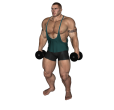 Raise - Dumbbell
Raise - Dumbbell
Benefits: Exercising the traps will provide a thicker, larger and more powerful back development which will help in other exercises and minimize injuries.
Purpose: This exercise develops the trapezoid muscles (upper back and shoulders).
Beginner Lateral Delts Triceps Strength Dumbbell Pull Gym
General Info: The trapezius is a large muscle group which is located in your upper body just below the neck and between your deltoid (shoulder) muscles. A prime means of working the traps directly is to use a shrug exercise.
 Raise - Water Bottle
Raise - Water Bottle
Benefits: Exercising the traps will provide a thicker, larger and more powerful back development which will help in other exercises and minimize injuries.
Purpose: This exercise develops the trapezoid muscles (upper back and shoulders).
Beginner Lateral Delts Triceps Strength Water Bottle Pull Home
General Info: The trapezius is a large muscle group which is located in your upper body just below the neck and between your deltoid (shoulder) muscles. A prime means of working the traps directly is to use a shrug exercise.
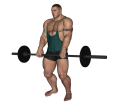 Reverse Curl - Barbell
Reverse Curl - Barbell
Benefits: Reverse curls work the forearms more than regular bicep curls.
Purpose: This exercise increases strength and produces greater functional strength in both the biceps and the forearms.
Beginner Biceps Forearms Strength Barbell Pull Gym
General Info: The biceps is a straight muscle with two heads. The long head of the biceps crosses both the elbow and the shoulder joints. It bends the elbow and raises the arm forward at the shoulder. The short head crosses the elbow joint and, in conjunction with the brachioradialis muscle, supinates the hand. When the hands are placed in a reverse grip, they work the forearm muscles more.
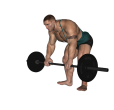 Reverse Curl - Bent Over Barbell
Reverse Curl - Bent Over Barbell
Benefits: Reverse curls work the forearms more than regular bicep curls. The reverse grip makes the exercise more difficult.
Purpose: This exercise increases strength and produces greater functional strength in both the biceps and the forearms.
Beginner Biceps Forearms Strength Barbell Pull Gym
General Info: The biceps is a straight muscle with two heads. The long head of the biceps crosses both the elbow and the shoulder joints. It bends the elbow and raises the arm forward at the shoulder. The short head crosses the elbow joint and, in conjunction with the brachioradialis muscle, supinates the hand. When the hands are placed in a reverse grip, they work the forearm muscles more.
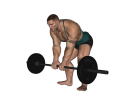 Reverse Curl - Bent Over Barbell Close Grip
Reverse Curl - Bent Over Barbell Close Grip
Benefits: Reverse curls work the forearms more than regular bicep curls. The reverse grip makes the exercise more difficult.
Purpose: This exercise increases strength and produces greater functional strength in both the biceps and the forearms.
Beginner Biceps Forearms Strength Barbell Pull Gym
General Info: The biceps is a straight muscle with two heads. The long head of the biceps crosses both the elbow and the shoulder joints. It bends the elbow and raises the arm forward at the shoulder. The short head crosses the elbow joint and, in conjunction with the brachioradialis muscle, supinates the hand. When the hands are placed in a reverse grip, they work the forearm muscles more.
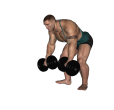 Reverse Curl - Bent Over Dumbbell
Reverse Curl - Bent Over Dumbbell
Benefits: This exercise is similar in effect to the Spider curl and does a good job of placing maximum tension on the biceps in the fully contracted position.
Purpose: This exercise works the biceps muscles but focuses also on the brachioradialis (a muscle that crosses the elbow joint and assists in rotating the forearm).
Beginner Biceps Forearms Shoulders Strength Dumbbell Pull Gym
General Info: The biceps is a straight muscle which has two heads. The long head crosses both the elbow and the shoulder joints. It bends the arm at the elbow and raises the arm forward at the shoulder. The short head crosses the elbow joint and, in conjunction with the brachioradialis, supinates the hand.
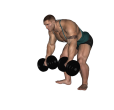 Reverse Curl - Bent Over Dumbbell Alternate
Reverse Curl - Bent Over Dumbbell Alternate
Benefits: This exercise is similar in effect to the Spider curl and does a good job of placing maximum tension on the biceps in the fully contracted position.
Purpose: This exercise works the biceps muscles but focuses also on the brachioradialis (a muscle that crosses the elbow joint and assists in rotating the forearm).
Beginner Biceps Forearms Shoulders Strength Dumbbell Pull Gym
General Info: The biceps is a straight muscle which has two heads. The long head crosses both the elbow and the shoulder joints. It bends the arm at the elbow and raises the arm forward at the shoulder. The short head crosses the elbow joint and, in conjunction with the brachioradialis, supinates the hand.
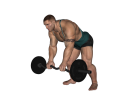 Reverse Curl - Bent Over EZ Bar
Reverse Curl - Bent Over EZ Bar
Benefits: Reverse curls work the forearms more than regular bicep curls.
Purpose: This exercise increases strength and produces greater functional strength in both the biceps and the forearms.
Beginner Biceps Forearms Strength EZ Bar Pull Gym
General Info: The biceps is a straight muscle with two heads. The long head of the biceps crosses both the elbow and the shoulder joints. It bends the elbow and raises the arm forward at the shoulder. The short head crosses the elbow joint and, in conjunction with the brachioradialis muscle, supinates the hand. When the hands are placed in a reverse grip, they work the forearm muscles more.
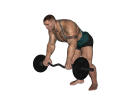 Reverse Curl - Bent Over EZ Bar Wide Grip
Reverse Curl - Bent Over EZ Bar Wide Grip
Benefits: Reverse curls work the forearms more than regular bicep curls.
Purpose: This exercise increases strength and produces greater functional strength in both the biceps and the forearms.
Beginner Biceps Forearms Strength EZ Bar Pull Gym
General Info: The biceps is a straight muscle with two heads. The long head of the biceps crosses both the elbow and the shoulder joints. It bends the elbow and raises the arm forward at the shoulder. The short head crosses the elbow joint and, in conjunction with the brachioradialis muscle, supinates the hand. When the hands are placed in a reverse grip, they work the forearm muscles more.
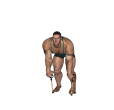 Reverse Curl - Bent Over Resistance Tube
Reverse Curl - Bent Over Resistance Tube
Benefits: This exercise is similar in effect to the Spider curl and does a good job of placing maximum tension on the biceps in the fully contracted position.
Purpose: This exercise works the biceps muscles but focuses also on the brachioradialis (a muscle that crosses the elbow joint and assists in rotating the forearm).
Beginner Biceps Forearms Shoulders Strength Resistance Tube Pull Gym
General Info: The biceps is a straight muscle which has two heads. The long head crosses both the elbow and the shoulder joints. It bends the arm at the elbow and raises the arm forward at the shoulder. The short head crosses the elbow joint and, in conjunction with the brachioradialis, supinates the hand.
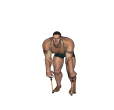 Reverse Curl - Bent Over Resistance Tube Alternate
Reverse Curl - Bent Over Resistance Tube Alternate
Benefits: This exercise is similar in effect to the Spider curl and does a good job of placing maximum tension on the biceps in the fully contracted position.
Purpose: This exercise works the biceps muscles but focuses also on the brachioradialis (a muscle that crosses the elbow joint and assists in rotating the forearm).
Beginner Biceps Forearms Shoulders Strength Resistance Tube Pull Gym
General Info: The biceps is a straight muscle which has two heads. The long head crosses both the elbow and the shoulder joints. It bends the arm at the elbow and raises the arm forward at the shoulder. The short head crosses the elbow joint and, in conjunction with the brachioradialis, supinates the hand.
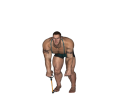 Reverse Curl - Bent Over Resistance Tube Single
Reverse Curl - Bent Over Resistance Tube Single
Benefits: This exercise is similar in effect to the Spider curl and does a good job of placing maximum tension on the biceps in the fully contracted position.
Purpose: This exercise works the biceps muscles but focuses also on the brachioradialis (a muscle that crosses the elbow joint and assists in rotating the forearm).
Beginner Biceps Forearms Shoulders Strength Resistance Tube Pull Gym
General Info: The biceps is a straight muscle which has two heads. The long head crosses both the elbow and the shoulder joints. It bends the arm at the elbow and raises the arm forward at the shoulder. The short head crosses the elbow joint and, in conjunction with the brachioradialis, supinates the hand.
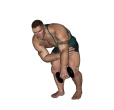 Reverse Curl - Bent Over Single Dumbbell
Reverse Curl - Bent Over Single Dumbbell
Benefits: This exercise is similar in effect to the Spider curl and does a good job of placing maximum tension on the biceps in the fully contracted position.
Purpose: This exercise works the biceps muscles but focuses also on the brachioradialis (a muscle that crosses the elbow joint and assists in rotating the forearm).
Beginner Biceps Forearms Shoulders Strength Dumbbell Pull Gym
General Info: The biceps is a straight muscle which has two heads. The long head crosses both the elbow and the shoulder joints. It bends the arm at the elbow and raises the arm forward at the shoulder. The short head crosses the elbow joint and, in conjunction with the brachioradialis, supinates the hand.
 Reverse Curl - Bent Over Single Water Bottle
Reverse Curl - Bent Over Single Water Bottle
Benefits: This exercise is similar in effect to the Spider curl and does a good job of placing maximum tension on the biceps in the fully contracted position.
Purpose: This exercise works the biceps muscles but focuses also on the brachioradialis (a muscle that crosses the elbow joint and assists in rotating the forearm).
Beginner Biceps Forearms Shoulders Strength Water Bottle Pull Home
General Info: The biceps is a straight muscle which has two heads. The long head crosses both the elbow and the shoulder joints. It bends the arm at the elbow and raises the arm forward at the shoulder. The short head crosses the elbow joint and, in conjunction with the brachioradialis, supinates the hand.
 Reverse Curl - Bent Over Water Bottle
Reverse Curl - Bent Over Water Bottle
Benefits: This exercise is similar in effect to the Spider curl and does a good job of placing maximum tension on the biceps in the fully contracted position.
Purpose: This exercise works the biceps muscles but focuses also on the brachioradialis (a muscle that crosses the elbow joint and assists in rotating the forearm).
Beginner Biceps Forearms Shoulders Strength Water Bottle Pull Home
General Info: The biceps is a straight muscle which has two heads. The long head crosses both the elbow and the shoulder joints. It bends the arm at the elbow and raises the arm forward at the shoulder. The short head crosses the elbow joint and, in conjunction with the brachioradialis, supinates the hand.
 Reverse Curl - Bent Over Water Bottle Alternate
Reverse Curl - Bent Over Water Bottle Alternate
Benefits: This exercise is similar in effect to the Spider curl and does a good job of placing maximum tension on the biceps in the fully contracted position.
Purpose: This exercise works the biceps muscles but focuses also on the brachioradialis (a muscle that crosses the elbow joint and assists in rotating the forearm).
Beginner Biceps Forearms Shoulders Strength Water Bottle Pull Home
General Info: The biceps is a straight muscle which has two heads. The long head crosses both the elbow and the shoulder joints. It bends the arm at the elbow and raises the arm forward at the shoulder. The short head crosses the elbow joint and, in conjunction with the brachioradialis, supinates the hand.
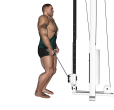 Reverse Curl - Cable
Reverse Curl - Cable
Benefits: Reverse curls work the forearms more than regular bicep curls.
Purpose: This exercise increases strength and produces greater functional strength in both the biceps and the forearms.
Beginner Forearms Biceps Strength Cable Machine Pull Gym
General Info: The biceps is a straight muscle with two heads. The long head of the biceps crosses both the elbow and the shoulder joints. It bends the elbow and raises the arm forward at the shoulder. The short head crosses the elbow joint and, in conjunction with the brachioradialis muscle, supinates the hand. When the hands are placed in a reverse grip, they work the forearm muscles more.
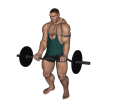 Reverse Curl - EZ Bar
Reverse Curl - EZ Bar
Benefits: This exercise puts the forearms in a stronger position, allowing you to lift heavier weights.
Purpose: This exercise is used to target the biceps muscle to develop size, definition, strength, endurance and power.
Beginner Biceps Forearms Shoulders Strength EZ Bar Pull Gym
General Info: The biceps is a straight muscle with two heads. The long head of the biceps crosses both the elbow and the shoulder joint. It bends the elbow and raises the arm forward at the shoulder. The short head crosses the elbow joint and, in conjunction with the brachioradialis, supinates the hand.
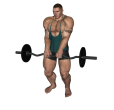 Reverse Curl - EZ Bar Close Grip
Reverse Curl - EZ Bar Close Grip
Benefits: This exercise puts the forearms in a stronger position, allowing you to lift heavier weights.
Purpose: This exercise is used to target the biceps muscle to develop size, definition, strength, endurance and power.
Beginner Biceps Forearms Shoulders Strength EZ Bar Pull Gym
General Info: The biceps is a straight muscle with two heads. The long head of the biceps crosses both the elbow and the shoulder joint. It bends the elbow and raises the arm forward at the shoulder. The short head crosses the elbow joint and, in conjunction with the brachioradialis, supinates the hand.
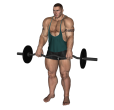 Reverse Curl - EZ Bar Narrow Stance
Reverse Curl - EZ Bar Narrow Stance
Benefits: This exercise puts the forearms in a stronger position, allowing you to lift heavier weights.
Purpose: This exercise is used to target the biceps muscle to develop size, definition, strength, endurance and power.
Beginner Biceps Forearms Shoulders Strength EZ Bar Pull Gym
General Info: The biceps is a straight muscle with two heads. The long head of the biceps crosses both the elbow and the shoulder joint. It bends the elbow and raises the arm forward at the shoulder. The short head crosses the elbow joint and, in conjunction with the brachioradialis, supinates the hand.
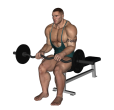 Reverse Curl - EZ Bar Seated
Reverse Curl - EZ Bar Seated
Benefits: This exercise puts the forearms in a stronger position, allowing you to lift heavier weights.
Purpose: This exercise is used to target the biceps muscle to develop size, definition, strength, endurance and power.
Beginner Biceps Forearms Shoulders Strength EZ Bar Flat Bench Pull Gym
General Info: The biceps is a straight muscle with two heads. The long head of the biceps crosses both the elbow and the shoulder joint. It bends the elbow and raises the arm forward at the shoulder. The short head crosses the elbow joint and, in conjunction with the brachioradialis, supinates the hand.
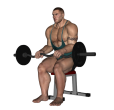 Reverse Curl - EZ Bar Seated Feet Up
Reverse Curl - EZ Bar Seated Feet Up
Benefits: This exercise puts the forearms in a stronger position, allowing you to lift heavier weights.
Purpose: This exercise is used to target the biceps muscle to develop size, definition, strength, endurance and power.
Beginner Biceps Forearms Shoulders Strength EZ Bar Flat Bench Pull Gym
General Info: The biceps is a straight muscle with two heads. The long head of the biceps crosses both the elbow and the shoulder joint. It bends the elbow and raises the arm forward at the shoulder. The short head crosses the elbow joint and, in conjunction with the brachioradialis, supinates the hand.
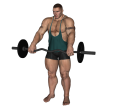 Reverse Curl - EZ Bar Wide Grip Narrow Stance
Reverse Curl - EZ Bar Wide Grip Narrow Stance
Benefits: This exercise puts the forearms in a stronger position, allowing you to lift heavier weights.
Purpose: This exercise is used to target the biceps muscle to develop size, definition, strength, endurance and power.
Beginner Biceps Forearms Shoulders Strength EZ Bar Pull Gym
General Info: The biceps is a straight muscle with two heads. The long head of the biceps crosses both the elbow and the shoulder joint. It bends the elbow and raises the arm forward at the shoulder. The short head crosses the elbow joint and, in conjunction with the brachioradialis, supinates the hand.
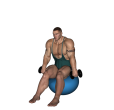 Reverse Curl - Fitness Ball Dumbbell
Reverse Curl - Fitness Ball Dumbbell
Benefits: Reverse curls work the forearms more than regular bicep curls.
Purpose: This exercise increases strength and produces greater functional strength in both the biceps and the forearms.
Beginner Biceps Forearms Strength Dumbbell Fitness Ball Pull Gym
General Info: The biceps is a straight muscle with two heads. The long head of the biceps crosses both the elbow and the shoulder joints. It bends the elbow and raises the arm forward at the shoulder. The short head crosses the elbow joint and, in conjunction with the brachioradialis muscle, supinates the hand. When the hands are placed in a reverse grip, they work the forearm muscles more.
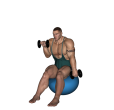 Reverse Curl - Fitness Ball Dumbbell Alternate
Reverse Curl - Fitness Ball Dumbbell Alternate
Benefits: Reverse curls work the forearms more than regular bicep curls.
Purpose: This exercise increases strength and produces greater functional strength in both the biceps and the forearms.
Beginner Biceps Forearms Shoulders Strength Dumbbell Fitness Ball Pull Gym
General Info: The biceps is a straight muscle with two heads. The long head of the biceps crosses both the elbow and the shoulder joint. It bends the elbow and raises the arm forward at the shoulder. The short head crosses the elbow joint and, in conjunction with the brachioradialis, supinates the hand.
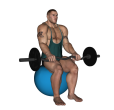 Reverse Curl - Fitness Ball EZ Bar
Reverse Curl - Fitness Ball EZ Bar
Benefits: Reverse curls work the forearms more than regular bicep curls.
Purpose: This exercise increases strength and produces greater functional strength in both the biceps and the forearms.
Beginner Biceps Forearms Strength EZ Bar Fitness Ball Pull Gym
General Info: The biceps is a straight muscle with two heads. The long head of the biceps crosses both the elbow and the shoulder joints. It bends the elbow and raises the arm forward at the shoulder. The short head crosses the elbow joint and, in conjunction with the brachioradialis muscle, supinates the hand. When the hands are placed in a reverse grip, they work the forearm muscles more.
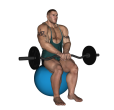 Reverse Curl - Fitness Ball EZ Bar Close Grip
Reverse Curl - Fitness Ball EZ Bar Close Grip
Benefits: Reverse curls work the forearms more than regular bicep curls.
Purpose: This exercise increases strength and produces greater functional strength in both the biceps and the forearms.
Beginner Biceps Forearms Strength EZ Bar Fitness Ball Pull Gym
General Info: The biceps is a straight muscle with two heads. The long head of the biceps crosses both the elbow and the shoulder joints. It bends the elbow and raises the arm forward at the shoulder. The short head crosses the elbow joint and, in conjunction with the brachioradialis muscle, supinates the hand. When the hands are placed in a reverse grip, they work the forearm muscles more.
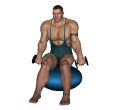 Reverse Curl - Fitness Ball Single Dumbbell
Reverse Curl - Fitness Ball Single Dumbbell
Benefits: Reverse curls work the forearms more than regular bicep curls.
Purpose: This exercise increases strength and produces greater functional strength in both the biceps and the forearms.
Beginner Biceps Forearms Shoulders Strength Dumbbell Fitness Ball Pull Gym
General Info: The biceps is a straight muscle with two heads. The long head of the biceps crosses both the elbow and the shoulder joint. It bends the elbow and raises the arm forward at the shoulder. The short head crosses the elbow joint and, in conjunction with the brachioradialis, supinates the hand.
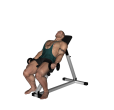 Reverse Curl - Incline Dumbbell
Reverse Curl - Incline Dumbbell
Benefits: Reverse curls work the forearms more than regular bicep curls.
Purpose: This exercise increases strength and produces greater functional strength in both the biceps and the forearms.
Beginner Biceps Forearms Anterior Shoulders Strength Dumbbell Incline Bench Pull Gym
General Info: The biceps muscle is a straight muscle with 2 heads. The long head crosses both the elbow and shoulder joints and bends the elbow and raises the arm forward at the shoulder. The short head of the biceps crosses the elbow joint and, in conjunction with the brachioradialis, supinates the hand.
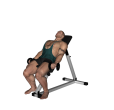 Reverse Curl - Incline Dumbbell Alternate
Reverse Curl - Incline Dumbbell Alternate
Benefits: Reverse curls work the forearms more than regular bicep curls.
Purpose: This exercise increases strength and produces greater functional strength in both the biceps and the forearms.
Beginner Biceps Forearms Anterior Shoulders Strength Dumbbell Incline Bench Pull Gym
General Info: The biceps muscle is a straight muscle with 2 heads. The long head crosses both the elbow and shoulder joints and bends the elbow and raises the arm forward at the shoulder. The short head of the biceps crosses the elbow joint and, in conjunction with the brachioradialis, supinates the hand.
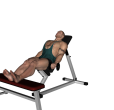 Reverse Curl - Incline Dumbbell Feet Up
Reverse Curl - Incline Dumbbell Feet Up
Benefits: Reverse curls work the forearms more than regular bicep curls.
Purpose: This exercise increases strength and produces greater functional strength in both the biceps and the forearms.
Beginner Biceps Forearms Anterior Shoulders Strength Dumbbell Incline Bench Pull Gym
General Info: The biceps muscle is a straight muscle with 2 heads. The long head crosses both the elbow and shoulder joints and bends the elbow and raises the arm forward at the shoulder. The short head of the biceps crosses the elbow joint and, in conjunction with the brachioradialis, supinates the hand.
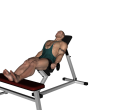 Reverse Curl - Incline Dumbbell Feet Up Alternate
Reverse Curl - Incline Dumbbell Feet Up Alternate
Benefits: Reverse curls work the forearms more than regular bicep curls.
Purpose: This exercise increases strength and produces greater functional strength in both the biceps and the forearms.
Beginner Biceps Forearms Anterior Shoulders Strength Dumbbell Incline Bench Pull Gym
General Info: The biceps muscle is a straight muscle with 2 heads. The long head crosses both the elbow and shoulder joints and bends the elbow and raises the arm forward at the shoulder. The short head of the biceps crosses the elbow joint and, in conjunction with the brachioradialis, supinates the hand.
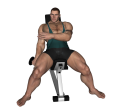 Reverse Curl - Incline Single Dumbbell
Reverse Curl - Incline Single Dumbbell
Benefits: Reverse curls work the forearms more than regular bicep curls.
Purpose: This exercise increases strength and produces greater functional strength in both the biceps and the forearms.
Beginner Biceps Forearms Shoulders Strength Dumbbell Incline Bench Pull Gym
General Info: The biceps is a straight muscle with two heads. The long head of the biceps crosses both the elbow and the shoulder joint. It bends the elbow and raises the arm forward at the shoulder. The short head crosses the elbow joint and, in conjunction with the brachioradialis, supinates the hand.
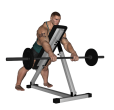 Reverse Curl - Overhang Barbell
Reverse Curl - Overhang Barbell
Benefits: This exercise is similar in effect to the Spider curl and does a good job of placing maximum tension on the biceps in the fully contracted position.
Purpose: This exercise works the biceps muscles.
Beginner Biceps Strength Barbell Incline Bench Pull Gym
General Info: The biceps muscle is a straight muscle with 2 heads. The long head crosses both the elbow and shoulder joints and bends the elbow and raises the arm forward at the shoulder. The short head of the biceps crosses the elbow joint and, in conjunction with the brachioradialis, supinates the hand.
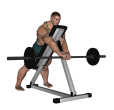 Reverse Curl - Overhang Barbell Close Grip
Reverse Curl - Overhang Barbell Close Grip
Benefits: This exercise is similar in effect to the Spider curl and does a good job of placing maximum tension on the biceps in the fully contracted position.
Purpose: This exercise works the biceps muscles.
Beginner Biceps Strength Barbell Incline Bench Pull Gym
General Info: The biceps muscle is a straight muscle with 2 heads. The long head crosses both the elbow and shoulder joints and bends the elbow and raises the arm forward at the shoulder. The short head of the biceps crosses the elbow joint and, in conjunction with the brachioradialis, supinates the hand.
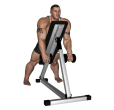 Reverse Curl - Overhang Dumbbell
Reverse Curl - Overhang Dumbbell
Benefits: This exercise is similar in effect to the Spider curl and does a good job of placing maximum tension on the biceps in the fully contracted position.
Purpose: This exercise works the biceps muscles.
Beginner Biceps Strength Dumbbell Incline Bench Pull Gym
General Info: The biceps muscle is a straight muscle with 2 heads. The long head crosses both the elbow and shoulder joints and bends the elbow and raises the arm forward at the shoulder. The short head of the biceps crosses the elbow joint and, in conjunction with the brachioradialis, supinates the hand.
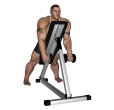 Reverse Curl - Overhang Dumbbell Alternate
Reverse Curl - Overhang Dumbbell Alternate
Benefits: This exercise is similar in effect to the Spider curl and does a good job of placing maximum tension on the biceps in the fully contracted position.
Purpose: This exercise works the biceps muscles.
Beginner Biceps Strength Dumbbell Incline Bench Pull Gym
General Info: The biceps muscle is a straight muscle with 2 heads. The long head crosses both the elbow and shoulder joints and bends the elbow and raises the arm forward at the shoulder. The short head of the biceps crosses the elbow joint and, in conjunction with the brachioradialis, supinates the hand.
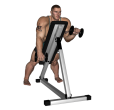 Reverse Curl - Overhang Dumbbell Single
Reverse Curl - Overhang Dumbbell Single
Benefits: This exercise is similar in effect to the Spider curl and does a good job of placing maximum tension on the biceps in the fully contracted position.
Purpose: This exercise works the biceps muscles.
Beginner Biceps Strength Dumbbell Incline Bench Pull Gym
General Info: The biceps muscle is a straight muscle with 2 heads. The long head crosses both the elbow and shoulder joints and bends the elbow and raises the arm forward at the shoulder. The short head of the biceps crosses the elbow joint and, in conjunction with the brachioradialis, supinates the hand.
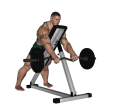 Reverse Curl - Overhang EZ Bar
Reverse Curl - Overhang EZ Bar
Benefits: This exercise is similar in effect to the Spider curl and does a good job of placing maximum tension on the biceps in the fully contracted position.
Purpose: This exercise works the biceps muscles.
Beginner Biceps Strength EZ Bar Incline Bench Pull Gym
General Info: The biceps muscle is a straight muscle with 2 heads. The long head crosses both the elbow and shoulder joints and bends the elbow and raises the arm forward at the shoulder. The short head of the biceps crosses the elbow joint and, in conjunction with the brachioradialis, supinates the hand.
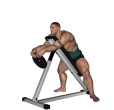 Reverse Curl - Overhang Plate
Reverse Curl - Overhang Plate
Benefits: This exercise is similar in effect to the Spider curl and does a good job of placing maximum tension on the biceps in the fully contracted position.
Purpose: This exercise works the biceps muscles.
Beginner Biceps Strength Plate Incline Bench Pull Gym
General Info: The biceps muscle is a straight muscle with 2 heads. The long head crosses both the elbow and shoulder joints and bends the elbow and raises the arm forward at the shoulder. The short head of the biceps crosses the elbow joint and, in conjunction with the brachioradialis, supinates the hand.
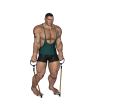 Reverse Curl - Resistance Tube
Reverse Curl - Resistance Tube
Benefits: This exercise places great relative intensity on the biceps muscle and is a basic bicep exercise.
Purpose: This exercise focuses on the biceps but also involves the brachioradialis.
Beginner Biceps Forearms Shoulders Strength Resistance Tube Pull Gym
General Info: The biceps is a straight muscle with two heads. The long head of the biceps crosses both the elbow and the shoulder joints. It bends the elbow and raises the arm forward at the shoulder. The short head crosses the elbow joint and, in conjunction with the brachioradialis muscle, supinates the hand.
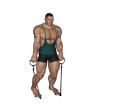 Reverse Curl - Resistance Tube Alternate
Reverse Curl - Resistance Tube Alternate
Benefits: This exercise places great relative intensity on the biceps muscle and is a basic bicep exercise.
Purpose: This exercise focuses on the biceps but also involves the brachioradialis.
Beginner Biceps Forearms Shoulders Strength Resistance Tube Pull Gym
General Info: The biceps is a straight muscle with two heads. The long head of the biceps crosses both the elbow and the shoulder joints. It bends the elbow and raises the arm forward at the shoulder. The short head crosses the elbow joint and, in conjunction with the brachioradialis muscle, supinates the hand.
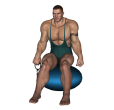 Reverse Curl - Resistance Tube Ball Single
Reverse Curl - Resistance Tube Ball Single
Benefits: This exercise isolates the biceps so that momentum does not come into play.
Purpose: This exercise strengthens the biceps.
Beginner Biceps Forearms Strength Fitness Ball Resistance Tube Pull Gym
General Info: The biceps muscle is a straight muscle with 2 heads. The long head crosses both the elbow and shoulder joints and bends the elbow and raises the arm forward at the shoulder. The short head of the biceps crosses the elbow joint and, in conjunction with the brachioradialis, supinates the hand.
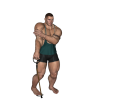 Reverse Curl - Resistance Tube Single
Reverse Curl - Resistance Tube Single
Benefits: This exercise isolates the biceps so that momentum does not come into play.
Purpose: This exercise strengthens the biceps.
Beginner Biceps Forearms Shoulders Strength Resistance Tube Pull Gym
General Info: The biceps is a straight muscle with two heads. The long head of the biceps crosses both the elbow and the shoulder joint. It bends the elbow and raises the arm forward at the shoulder. The short head crosses the elbow joint and, in conjunction with the brachioradialis, supinates the hand.
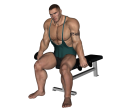 Reverse Curl - Seated Dumbbell
Reverse Curl - Seated Dumbbell
Benefits: This exercise isolates the biceps so that momentum does not come into play.
Purpose: This exercise strengthens the biceps.
Beginner Biceps Forearms Shoulders Traps Strength Dumbbell Flat Bench Pull Gym
General Info: The biceps muscle is a straight muscle with 2 heads. The long head crosses both the elbow and shoulder joints and bends the elbow and raises the arm forward at the shoulder. The short head of the biceps crosses the elbow joint and, in conjunction with the brachioradialis, supinates the hand..
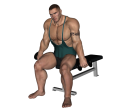 Reverse Curl - Seated Dumbbell Alternate
Reverse Curl - Seated Dumbbell Alternate
Benefits: This exercise isolates the biceps so that momentum does not come into play.
Purpose: This exercise strengthens the biceps.
Beginner Biceps Forearms Shoulders Traps Strength Dumbbell Flat Bench Pull Gym
General Info: The biceps muscle is a straight muscle with 2 heads. The long head crosses both the elbow and shoulder joints and bends the elbow and raises the arm forward at the shoulder. The short head of the biceps crosses the elbow joint and, in conjunction with the brachioradialis, supinates the hand..
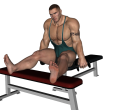 Reverse Curl - Seated Dumbbell Feet Up
Reverse Curl - Seated Dumbbell Feet Up
Benefits: This exercise isolates the biceps so that momentum does not come into play. It also works the forearms.
Purpose: This exercise strengthens the biceps.
Beginner Biceps Forearms Shoulders Traps Strength Dumbbell Flat Bench Pull Gym
General Info: The biceps muscle is a straight muscle with 2 heads. The long head crosses both the elbow and shoulder joints and bends the elbow and raises the arm forward at the shoulder. The short head of the biceps crosses the elbow joint and, in conjunction with the brachioradialis, supinates the hand..
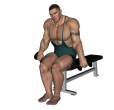 Reverse Curl - Seated Dumbbell Narrow Alternate
Reverse Curl - Seated Dumbbell Narrow Alternate
Benefits: This exercise isolates the biceps so that momentum does not come into play. It also works the forearms.
Purpose: This exercise strengthens the biceps.
Beginner Biceps Forearms Shoulders Traps Strength Dumbbell Flat Bench Pull Gym
General Info: The biceps muscle is a straight muscle with 2 heads. The long head crosses both the elbow and shoulder joints and bends the elbow and raises the arm forward at the shoulder. The short head of the biceps crosses the elbow joint and, in conjunction with the brachioradialis, supinates the hand..
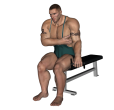 Reverse Curl - Seated Dumbbell Single
Reverse Curl - Seated Dumbbell Single
Benefits: This exercise isolates the biceps so that momentum does not come into play. It also works the forearms.
Purpose: This exercise strengthens the biceps.
Beginner Biceps Forearms Shoulders Traps Strength Dumbbell Flat Bench Pull Gym
General Info: The biceps muscle is a straight muscle with 2 heads. The long head crosses both the elbow and shoulder joints and bends the elbow and raises the arm forward at the shoulder. The short head of the biceps crosses the elbow joint and, in conjunction with the brachioradialis, supinates the hand..
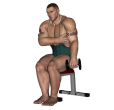 Reverse Curl - Seated Dumbbell Single Narrow
Reverse Curl - Seated Dumbbell Single Narrow
Benefits: This exercise isolates the biceps so that momentum does not come into play. It also works the forearms.
Purpose: This exercise strengthens the biceps.
Beginner Biceps Forearms Shoulders Traps Strength Dumbbell Flat Bench Pull Gym
General Info: The biceps muscle is a straight muscle with 2 heads. The long head crosses both the elbow and shoulder joints and bends the elbow and raises the arm forward at the shoulder. The short head of the biceps crosses the elbow joint and, in conjunction with the brachioradialis, supinates the hand..
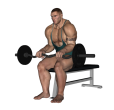 Reverse Curl - Seated EZ Bar
Reverse Curl - Seated EZ Bar
Benefits: This exercise isolates the biceps so that momentum does not come into play. It also works the forearms.
Purpose: This exercise strengthens the biceps.
Beginner Biceps Forearms Shoulders Traps Strength EZ Bar Flat Bench Pull Gym
General Info: The biceps muscle is a straight muscle with 2 heads. The long head crosses both the elbow and shoulder joints and bends the elbow and raises the arm forward at the shoulder. The short head of the biceps crosses the elbow joint and, in conjunction with the brachioradialis, supinates the hand..
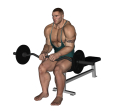 Reverse Curl - Seated EZ Bar Close Grip
Reverse Curl - Seated EZ Bar Close Grip
Benefits: This exercise isolates the biceps so that momentum does not come into play. It also works the forearms.
Purpose: This exercise strengthens the biceps.
Beginner Biceps Forearms Shoulders Traps Strength EZ Bar Flat Bench Pull Gym
General Info: The biceps muscle is a straight muscle with 2 heads. The long head crosses both the elbow and shoulder joints and bends the elbow and raises the arm forward at the shoulder. The short head of the biceps crosses the elbow joint and, in conjunction with the brachioradialis, supinates the hand..
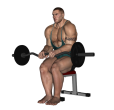 Reverse Curl - Seated EZ Bar Close Narrow
Reverse Curl - Seated EZ Bar Close Narrow
Benefits: This exercise isolates the biceps so that momentum does not come into play. It also works the forearms.
Purpose: This exercise strengthens the biceps.
Beginner Biceps Forearms Shoulders Traps Strength EZ Bar Flat Bench Pull Gym
General Info: The biceps muscle is a straight muscle with 2 heads. The long head crosses both the elbow and shoulder joints and bends the elbow and raises the arm forward at the shoulder. The short head of the biceps crosses the elbow joint and, in conjunction with the brachioradialis, supinates the hand..
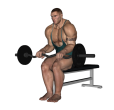 Reverse Curl - Seated EZ Bar Narrow
Reverse Curl - Seated EZ Bar Narrow
Benefits: This exercise isolates the biceps so that momentum does not come into play. It also works the forearms.
Purpose: This exercise strengthens the biceps.
Beginner Biceps Forearms Shoulders Traps Strength EZ Bar Flat Bench Pull Gym
General Info: The biceps muscle is a straight muscle with 2 heads. The long head crosses both the elbow and shoulder joints and bends the elbow and raises the arm forward at the shoulder. The short head of the biceps crosses the elbow joint and, in conjunction with the brachioradialis, supinates the hand..
 Reverse Curl - Seated Water Bottle
Reverse Curl - Seated Water Bottle
Benefits: This exercise isolates the biceps so that momentum does not come into play.
Purpose: This exercise strengthens the biceps.
Beginner Biceps Forearms Shoulders Traps Strength Water Bottle Chair Pull Home
General Info: The biceps muscle is a straight muscle with 2 heads. The long head crosses both the elbow and shoulder joints and bends the elbow and raises the arm forward at the shoulder. The short head of the biceps crosses the elbow joint and, in conjunction with the brachioradialis, supinates the hand..
 Reverse Curl - Seated Water Bottle Alternate
Reverse Curl - Seated Water Bottle Alternate
Benefits: This exercise isolates the biceps so that momentum does not come into play.
Purpose: This exercise strengthens the biceps.
Beginner Biceps Forearms Shoulders Traps Strength Water Bottle Chair Pull Home
General Info: The biceps muscle is a straight muscle with 2 heads. The long head crosses both the elbow and shoulder joints and bends the elbow and raises the arm forward at the shoulder. The short head of the biceps crosses the elbow joint and, in conjunction with the brachioradialis, supinates the hand..
 Reverse Curl - Seated Water Bottle Feet Up
Reverse Curl - Seated Water Bottle Feet Up
Benefits: This exercise isolates the biceps so that momentum does not come into play.
Purpose: This exercise strengthens the biceps.
Beginner Biceps Forearms Shoulders Traps Strength Water Bottle Chair Pull Home
General Info: The biceps muscle is a straight muscle with 2 heads. The long head crosses both the elbow and shoulder joints and bends the elbow and raises the arm forward at the shoulder. The short head of the biceps crosses the elbow joint and, in conjunction with the brachioradialis, supinates the hand..
 Reverse Curl - Seated Water Bottle Narrow Alternate
Reverse Curl - Seated Water Bottle Narrow Alternate
Benefits: This exercise isolates the biceps so that momentum does not come into play.
Purpose: This exercise strengthens the biceps.
Beginner Biceps Forearms Shoulders Traps Strength Water Bottle Chair Pull Home
General Info: The biceps muscle is a straight muscle with 2 heads. The long head crosses both the elbow and shoulder joints and bends the elbow and raises the arm forward at the shoulder. The short head of the biceps crosses the elbow joint and, in conjunction with the brachioradialis, supinates the hand..
 Reverse Curl - Seated Water Bottle Single
Reverse Curl - Seated Water Bottle Single
Benefits: This exercise isolates the biceps so that momentum does not come into play.
Purpose: This exercise strengthens the biceps.
Beginner Biceps Forearms Shoulders Traps Strength Water Bottle Chair Pull Home
General Info: The biceps muscle is a straight muscle with 2 heads. The long head crosses both the elbow and shoulder joints and bends the elbow and raises the arm forward at the shoulder. The short head of the biceps crosses the elbow joint and, in conjunction with the brachioradialis, supinates the hand..
 Reverse Curl - Seated Water Bottle Single Narrow
Reverse Curl - Seated Water Bottle Single Narrow
Benefits: This exercise isolates the biceps so that momentum does not come into play.
Purpose: This exercise strengthens the biceps.
Beginner Biceps Forearms Shoulders Traps Strength Water Bottle Chair Pull Home
General Info: The biceps muscle is a straight muscle with 2 heads. The long head crosses both the elbow and shoulder joints and bends the elbow and raises the arm forward at the shoulder. The short head of the biceps crosses the elbow joint and, in conjunction with the brachioradialis, supinates the hand..
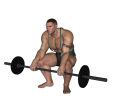 Reverse Curl - Squat Barbell
Reverse Curl - Squat Barbell
Benefits: Reverse curls work the forearms more than regular bicep curls.
Purpose: This exercise increases strength and produces greater functional strength in both the biceps and the forearms.
Beginner Biceps Forearms Strength Barbell Pull Gym
General Info: The biceps is a straight muscle with two heads. The long head of the biceps crosses both the elbow and the shoulder joints. It bends the elbow and raises the arm forward at the shoulder. The short head crosses the elbow joint and, in conjunction with the brachioradialis muscle, supinates the hand. When the hands are placed in a reverse grip, they work the forearm muscles more.
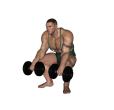 Reverse Curl - Squat Dumbbell
Reverse Curl - Squat Dumbbell
Benefits: Reverse curls work the forearms more than regular bicep curls.
Purpose: This exercise increases strength and produces greater functional strength in both the biceps and the forearms.
Beginner Biceps Forearms Strength Dumbbell Pull Gym
General Info: The biceps is a straight muscle with two heads. The long head of the biceps crosses both the elbow and the shoulder joints. It bends the elbow and raises the arm forward at the shoulder. The short head crosses the elbow joint and, in conjunction with the brachioradialis muscle, supinates the hand. When the hands are placed in a reverse grip, they work the forearm muscles more.
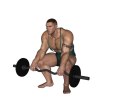 Reverse Curl - Squat EZ Bar
Reverse Curl - Squat EZ Bar
Benefits: Reverse curls work the forearms more than regular bicep curls.
Purpose: This exercise increases strength and produces greater functional strength in both the biceps and the forearms.
Beginner Biceps Forearms Strength EZ Bar Pull Gym
General Info: The biceps is a straight muscle with two heads. The long head of the biceps crosses both the elbow and the shoulder joints. It bends the elbow and raises the arm forward at the shoulder. The short head crosses the elbow joint and, in conjunction with the brachioradialis muscle, supinates the hand. When the hands are placed in a reverse grip, they work the forearm muscles more.
 Reverse Curl - Squat Water Bottle
Reverse Curl - Squat Water Bottle
Benefits: Reverse curls work the forearms more than regular bicep curls.
Purpose: This exercise increases strength and produces greater functional strength in both the biceps and the forearms.
Beginner Biceps Forearms Strength Water Bottle Pull Home
General Info: The biceps is a straight muscle with two heads. The long head of the biceps crosses both the elbow and the shoulder joints. It bends the elbow and raises the arm forward at the shoulder. The short head crosses the elbow joint and, in conjunction with the brachioradialis muscle, supinates the hand. When the hands are placed in a reverse grip, they work the forearm muscles more.
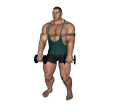 Reverse Curl - Standing Dumbbell
Reverse Curl - Standing Dumbbell
Benefits: Reverse curls work the forearms in addition to the biceps.
Purpose: This exercise increases strength and produces greater functional strength in both the biceps and the forearms.
Beginner Forearms Biceps Strength Dumbbell Pull Gym
General Info: The biceps is a straight muscle with two heads. The long head of the biceps crosses both the elbow and the shoulder joint. It bends the elbow and raises the arm forward at the shoulder. The short head crosses the elbow joint and, in conjunction with the brachioradialis, supinates the hand.
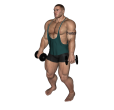 Reverse Curl - Standing Dumbbell Alternate
Reverse Curl - Standing Dumbbell Alternate
Benefits: This exercise works both heads of the biceps with a heavier weight than can typically be done with dumbbells.
Purpose: This exercise is used to target the biceps muscle to develop size, definition, strength, endurance and power.
Beginner Biceps Forearms Shoulders Strength Dumbbell Pull Gym
General Info: The biceps is a straight muscle with two heads. The long head of the biceps crosses both the elbow and the shoulder joint. It bends the elbow and raises the arm forward at the shoulder. The short head crosses the elbow joint and, in conjunction with the brachioradialis, supinates the hand.
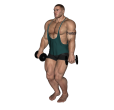 Reverse Curl - Standing Dumbbell Narrow Stance
Reverse Curl - Standing Dumbbell Narrow Stance
Benefits: This exercise works both heads of the biceps. It also works the forearms.
Purpose: This exercise is used to target the biceps muscle to develop size, definition, strength, endurance and power.
Beginner Biceps Forearms Shoulders Strength Dumbbell Pull Gym
General Info: The biceps is a straight muscle with two heads. The long head of the biceps crosses both the elbow and the shoulder joint. It bends the elbow and raises the arm forward at the shoulder. The short head crosses the elbow joint and, in conjunction with the brachioradialis, supinates the hand.
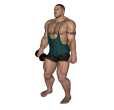 Reverse Curl - Standing Dumbbell Single
Reverse Curl - Standing Dumbbell Single
Benefits: This exercise isolates the biceps so that momentum does not come into play. It also works the forearms.
Purpose: This exercise strengthens the biceps.
Beginner Biceps Forearms Shoulders Traps Strength Dumbbell Pull Gym
General Info: The biceps muscle is a straight muscle with 2 heads. The long head crosses both the elbow and shoulder joints and bends the elbow and raises the arm forward at the shoulder. The short head of the biceps crosses the elbow joint and, in conjunction with the brachioradialis, supinates the hand..
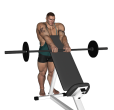 Reverse Curl - Standing Incline Barbell
Reverse Curl - Standing Incline Barbell
Benefits: This exercise works both heads of the biceps with a heavier weight than can typically be done with dumbbells. It is very similar to a preacher curl. It also works the forearms.
Purpose: This exercise is used to target the biceps muscle to develop size, definition, strength, endurance and power.
Beginner Biceps Forearms Shoulders Strength Barbell Incline Bench Pull Gym
General Info: The biceps is a straight muscle with two heads. The long head of the biceps crosses both the elbow and the shoulder joint. It bends the elbow and raises the arm forward at the shoulder. The short head crosses the elbow joint and, in conjunction with the brachioradialis, supinates the hand.
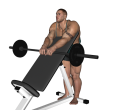 Reverse Curl - Standing Incline Barbell Close
Reverse Curl - Standing Incline Barbell Close
Benefits: This exercise works both heads of the biceps with a heavier weight than can typically be done with dumbbells. It is very similar to a preacher curl. It also works the forearms.
Purpose: This exercise is used to target the biceps muscle to develop size, definition, strength, endurance and power.
Beginner Biceps Forearms Shoulders Strength Barbell Incline Bench Pull Gym
General Info: The biceps is a straight muscle with two heads. The long head of the biceps crosses both the elbow and the shoulder joint. It bends the elbow and raises the arm forward at the shoulder. The short head crosses the elbow joint and, in conjunction with the brachioradialis, supinates the hand.
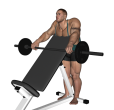 Reverse Curl - Standing Incline Barbell Wide Grip
Reverse Curl - Standing Incline Barbell Wide Grip
Benefits: This exercise works both heads of the biceps with a heavier weight than can typically be done with dumbbells. It is very similar to a preacher curl. It also works the forearms.
Purpose: This exercise is used to target the biceps muscle to develop size, definition, strength, endurance and power.
Beginner Biceps Forearms Shoulders Strength Barbell Incline Bench Pull Gym
General Info: The biceps is a straight muscle with two heads. The long head of the biceps crosses both the elbow and the shoulder joint. It bends the elbow and raises the arm forward at the shoulder. The short head crosses the elbow joint and, in conjunction with the brachioradialis, supinates the hand.
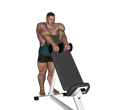 Reverse Curl - Standing Incline Dumbbell
Reverse Curl - Standing Incline Dumbbell
Benefits: This exercise works both heads of the biceps. It is very similar to a preacher curl. It also works the forearms.
Purpose: This exercise is used to target the biceps muscle to develop size, definition, strength, endurance and power.
Beginner Biceps Forearms Shoulders Strength Dumbbell Incline Bench Pull Gym
General Info: The biceps is a straight muscle with two heads. The long head of the biceps crosses both the elbow and the shoulder joint. It bends the elbow and raises the arm forward at the shoulder. The short head crosses the elbow joint and, in conjunction with the brachioradialis, supinates the hand.
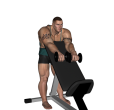 Reverse Curl - Standing Incline Dumbbell Alternate
Reverse Curl - Standing Incline Dumbbell Alternate
Benefits: This exercise works both heads of the biceps. It is very similar to a preacher curl. It also works the forearms.
Purpose: This exercise is used to target the biceps muscle to develop size, definition, strength, endurance and power.
Beginner Biceps Forearms Shoulders Strength Dumbbell Incline Bench Pull Gym
General Info: The biceps is a straight muscle with two heads. The long head of the biceps crosses both the elbow and the shoulder joint. It bends the elbow and raises the arm forward at the shoulder. The short head crosses the elbow joint and, in conjunction with the brachioradialis, supinates the hand.
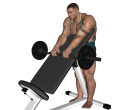 Reverse Curl - Standing Incline EZ Bar
Reverse Curl - Standing Incline EZ Bar
Benefits: This exercise works both heads of the biceps with a heavier weight than can typically be done with dumbbells.
Purpose: This exercise is used to target the biceps muscle to develop size, definition, strength, endurance and power.
Beginner Biceps Forearms Shoulders Strength EZ Bar Incline Bench Pull Gym
General Info: The biceps is a straight muscle with two heads. The long head of the biceps crosses both the elbow and the shoulder joint. It bends the elbow and raises the arm forward at the shoulder. The short head crosses the elbow joint and, in conjunction with the brachioradialis, supinates the hand.
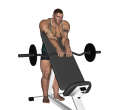 Reverse Curl - Standing Incline EZ Bar Close Grip
Reverse Curl - Standing Incline EZ Bar Close Grip
Benefits: This exercise works both heads of the biceps with a heavier weight than can typically be done with dumbbells. It is very similar to a preacher curl. It also works the forearms.
Purpose: This exercise is used to target the biceps muscle to develop size, definition, strength, endurance and power.
Beginner Biceps Forearms Shoulders Strength EZ Bar Incline Bench Pull Gym
General Info: The biceps is a straight muscle with two heads. The long head of the biceps crosses both the elbow and the shoulder joint. It bends the elbow and raises the arm forward at the shoulder. The short head crosses the elbow joint and, in conjunction with the brachioradialis, supinates the hand.
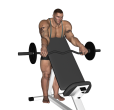 Reverse Curl - Standing Incline EZ Bar Wide Grip
Reverse Curl - Standing Incline EZ Bar Wide Grip
Benefits: This exercise works both heads of the biceps with a heavier weight than can typically be done with dumbbells. It is very similar to a preacher curl. It also works the forearms.
Purpose: This exercise is used to target the biceps muscle to develop size, definition, strength, endurance and power.
Beginner Biceps Forearms Shoulders Strength EZ Bar Incline Bench Pull Gym
General Info: The biceps is a straight muscle with two heads. The long head of the biceps crosses both the elbow and the shoulder joint. It bends the elbow and raises the arm forward at the shoulder. The short head crosses the elbow joint and, in conjunction with the brachioradialis, supinates the hand.
 Reverse Curl - Standing Water Bottle
Reverse Curl - Standing Water Bottle
Benefits: Reverse curls work the forearms in addition to the biceps.
Purpose: This exercise increases strength and produces greater functional strength in both the biceps and the forearms.
Beginner Forearms Biceps Strength Water Bottle Pull Home
General Info: The biceps is a straight muscle with two heads. The long head of the biceps crosses both the elbow and the shoulder joint. It bends the elbow and raises the arm forward at the shoulder. The short head crosses the elbow joint and, in conjunction with the brachioradialis, supinates the hand.
 Reverse Curl - Standing Water Bottle Alternate
Reverse Curl - Standing Water Bottle Alternate
Benefits: This exercise isolates the biceps so that momentum does not come into play.
Purpose: This exercise strengthens the biceps.
Beginner Biceps Forearms Shoulders Traps Strength Water Bottle Pull Home
General Info: The biceps muscle is a straight muscle with 2 heads. The long head crosses both the elbow and shoulder joints and bends the elbow and raises the arm forward at the shoulder. The short head of the biceps crosses the elbow joint and, in conjunction with the brachioradialis, supinates the hand..
 Reverse Curl - Standing Water Bottle Narrow
Reverse Curl - Standing Water Bottle Narrow
Benefits: Reverse curls work the forearms in addition to the biceps.
Purpose: This exercise increases strength and produces greater functional strength in both the biceps and the forearms.
Beginner Forearms Biceps Strength Water Bottle Pull Home
General Info: The biceps is a straight muscle with two heads. The long head of the biceps crosses both the elbow and the shoulder joint. It bends the elbow and raises the arm forward at the shoulder. The short head crosses the elbow joint and, in conjunction with the brachioradialis, supinates the hand.
 Reverse Curl - Standing Water Bottle Single
Reverse Curl - Standing Water Bottle Single
Benefits: This exercise isolates the biceps so that momentum does not come into play.
Purpose: This exercise strengthens the biceps.
Beginner Biceps Forearms Shoulders Traps Strength Water Bottle Chair Pull Home
General Info: The biceps muscle is a straight muscle with 2 heads. The long head crosses both the elbow and shoulder joints and bends the elbow and raises the arm forward at the shoulder. The short head of the biceps crosses the elbow joint and, in conjunction with the brachioradialis, supinates the hand..
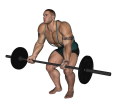 Reverse Row - Barbell
Reverse Row - Barbell
Benefits: This exercise is a strong, effective free weight back exercise for building muscle mass and size of the lats.
Purpose: This is a good exercise for increasing strength and size in the upper back.
Intermediate Traps Lats Triceps Posterior Delts Strength Barbell Pull Compound Gym
General Info: There are a number of muscles in the back, although the two major muscles are the lats and traps. The lats pulls the arm back and down towards the spine. The traps pull the shoulder blades back and towards the spine.
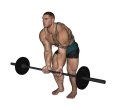 Reverse Row - Barbell Close Grip
Reverse Row - Barbell Close Grip
Benefits: This exercise is a strong, effective free weight back exercise for building muscle mass and size of the lats.
Purpose: This is a good exercise for increasing strength and size in the upper back.
Intermediate Traps Lats Triceps Posterior Delts Strength Barbell Pull Compound Gym
General Info: There are a number of muscles in the back, although the two major muscles are the lats and traps. The lats pulls the arm back and down towards the spine. The traps pull the shoulder blades back and towards the spine.
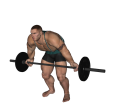 Reverse Row - Barbell Wide Grip
Reverse Row - Barbell Wide Grip
Benefits: This exercise is a strong, effective free weight back exercise for building muscle mass and size of the lats.
Purpose: This is a good exercise for increasing strength and size in the upper back.
Intermediate Traps Lats Triceps Posterior Delts Strength Barbell Pull Compound Gym
General Info: There are a number of muscles in the back, although the two major muscles are the lats and traps. The lats pulls the arm back and down towards the spine. The traps pull the shoulder blades back and towards the spine.
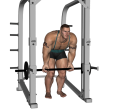 Reverse Row - Bent Knee Smith Machine
Reverse Row - Bent Knee Smith Machine
Benefits: This exercise is a strong, effective free weight back exercise for building muscle mass and size of the lats.
Purpose: This is a good exercise for increasing strength and size in the upper back.
Intermediate Traps Lats Triceps Posterior Delts Strength Smith Machine Pull Compound Gym
General Info: There are a number of muscles in the back, although the two major muscles are the lats and traps. The lats pulls the arm back and down towards the spine. The traps pull the shoulder blades back and towards the spine.
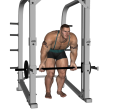 Reverse Row - Bent Knee Smith Wide
Reverse Row - Bent Knee Smith Wide
Benefits: This exercise is a strong, effective free weight back exercise for building muscle mass and size of the lats.
Purpose: This is a good exercise for increasing strength and size in the upper back.
Intermediate Traps Lats Triceps Posterior Delts Strength Smith Machine Pull Compound Gym
General Info: There are a number of muscles in the back, although the two major muscles are the lats and traps. The lats pulls the arm back and down towards the spine. The traps pull the shoulder blades back and towards the spine.
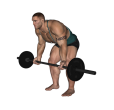 Reverse Row - Bent Over
Reverse Row - Bent Over
Benefits: This exercise is a strong, effective free weight back exercise for building muscle mass and size of the lats.
Purpose: This is a good exercise for increasing strength and size in the middle back.
Intermediate Traps Lats Triceps Posterior Delts Strength Barbell Pull Compound Gym
General Info: There are a number of muscles in the back, although the two major muscles are the lats and traps. The lats pulls the arm back and down towards the spine. The traps pull the shoulder blades back and towards the spine.
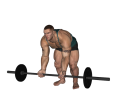 Reverse Row - Bent Over Barbell
Reverse Row - Bent Over Barbell
Benefits: This exercise is a strong, effective free weight back exercise for building muscle mass and size of the lats.
Purpose: This is a good exercise for increasing strength and size in the upper back.
Intermediate Traps Lats Triceps Posterior Delts Strength Barbell Pull Compound Gym
General Info: There are a number of muscles in the back, although the two major muscles are the lats and traps. The lats pulls the arm back and down towards the spine. The traps pull the shoulder blades back and towards the spine.
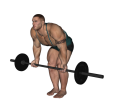 Reverse Row - Bent Over Barbell Narrow Stance
Reverse Row - Bent Over Barbell Narrow Stance
Benefits: This exercise is a strong, effective free weight back exercise for building muscle mass and size of the lats.
Purpose: This is a good exercise for increasing strength and size in the upper back.
Intermediate Traps Lats Triceps Posterior Delts Strength Barbell Pull Compound Gym
General Info: There are a number of muscles in the back, although the two major muscles are the lats and traps. The lats pulls the arm back and down towards the spine. The traps pull the shoulder blades back and towards the spine.
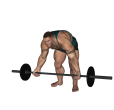 Reverse Row - Bent Over Barbell Wide
Reverse Row - Bent Over Barbell Wide
Benefits: This exercise is a strong, effective free weight back exercise for building muscle mass and size of the lats.
Purpose: This is a good exercise for increasing strength and size in the upper back.
Intermediate Traps Lats Triceps Posterior Delts Strength Barbell Pull Compound Gym
General Info: There are a number of muscles in the back, although the two major muscles are the lats and traps. The lats pulls the arm back and down towards the spine. The traps pull the shoulder blades back and towards the spine.
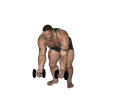 Reverse Row - Bent Over Dumbbell
Reverse Row - Bent Over Dumbbell
Benefits: This exercise is a strong, effective free weight back exercise for building muscle mass and size of the lats.
Purpose: This is a good exercise for increasing strength and size in the upper back.
Intermediate Traps Lats Triceps Posterior Delts Strength Dumbbell Pull Compound Gym
General Info: There are a number of muscles in the back, although the two major muscles are the lats and traps. The lats pulls the arm back and down towards the spine. The traps pull the shoulder blades back and towards the spine.
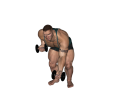 Reverse Row - Bent Over Dumbbell Alternate
Reverse Row - Bent Over Dumbbell Alternate
Benefits: This exercise is a strong, effective free weight back exercise for building muscle mass and size of the lats.
Purpose: This is a good exercise for increasing strength and size in the upper back.
Intermediate Traps Lats Triceps Posterior Delts Strength Dumbbell Pull Compound Gym
General Info: There are a number of muscles in the back, although the two major muscles are the lats and traps. The lats pulls the arm back and down towards the spine. The traps pull the shoulder blades back and towards the spine.
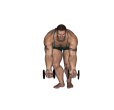 Reverse Row - Bent Over Dumbbell Narrow Stance
Reverse Row - Bent Over Dumbbell Narrow Stance
Benefits: This exercise is a strong, effective free weight back exercise for building muscle mass and size of the lats.
Purpose: This is a good exercise for increasing strength and size in the upper back.
Intermediate Traps Lats Triceps Posterior Delts Strength Dumbbell Pull Compound Gym
General Info: There are a number of muscles in the back, although the two major muscles are the lats and traps. The lats pulls the arm back and down towards the spine. The traps pull the shoulder blades back and towards the spine.
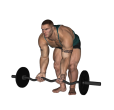 Reverse Row - Bent Over EZ Bar Narrow Stance
Reverse Row - Bent Over EZ Bar Narrow Stance
Benefits: This exercise is a strong, effective free weight back exercise for building muscle mass and size of the lats.
Purpose: This is a good exercise for increasing strength and size in the upper back.
Intermediate Traps Lats Triceps Posterior Delts Strength EZ Bar Pull Compound Gym
General Info: There are a number of muscles in the back, although the two major muscles are the lats and traps. The lats pulls the arm back and down towards the spine. The traps pull the shoulder blades back and towards the spine.
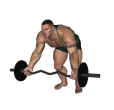 Reverse Row - Bent Over EZ Bar Wide Grip
Reverse Row - Bent Over EZ Bar Wide Grip
Benefits: This exercise is a strong, effective free weight back exercise for building muscle mass and size of the lats.
Purpose: This is a good exercise for increasing strength and size in the upper back.
Intermediate Traps Lats Triceps Posterior Delts Strength EZ Bar Pull Compound Gym
General Info: There are a number of muscles in the back, although the two major muscles are the lats and traps. The lats pulls the arm back and down towards the spine. The traps pull the shoulder blades back and towards the spine.
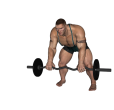 Reverse Row - Bent Over EZ Bar Wide Stance
Reverse Row - Bent Over EZ Bar Wide Stance
Benefits: This exercise is a strong, effective free weight back exercise for building muscle mass and size of the lats.
Purpose: This is a good exercise for increasing strength and size in the upper back.
Intermediate Traps Lats Triceps Posterior Delts Strength EZ Bar Pull Compound Gym
General Info: There are a number of muscles in the back, although the two major muscles are the lats and traps. The lats pulls the arm back and down towards the spine. The traps pull the shoulder blades back and towards the spine.
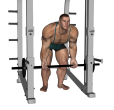 Reverse Row - Bent Over Smith Machine
Reverse Row - Bent Over Smith Machine
Benefits: This exercise is a strong, effective free weight back exercise for building muscle mass and size of the lats.
Purpose: This is a good exercise for increasing strength and size in the upper back.
Intermediate Traps Lats Triceps Posterior Delts Strength Smith Machine Pull Compound Gym
General Info: There are a number of muscles in the back, although the two major muscles are the lats and traps. The lats pulls the arm back and down towards the spine. The traps pull the shoulder blades back and towards the spine.
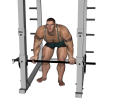 Reverse Row - Bent Over Smith Wide
Reverse Row - Bent Over Smith Wide
Benefits: This exercise is a strong, effective free weight back exercise for building muscle mass and size of the lats.
Purpose: This is a good exercise for increasing strength and size in the upper back.
Intermediate Traps Lats Triceps Posterior Delts Strength Smith Machine Pull Compound Gym
General Info: There are a number of muscles in the back, although the two major muscles are the lats and traps. The lats pulls the arm back and down towards the spine. The traps pull the shoulder blades back and towards the spine.
 Reverse Row - Bent Over Water Bottle
Reverse Row - Bent Over Water Bottle
Benefits: This exercise is a strong, effective free weight back exercise for building muscle mass and size of the lats.
Purpose: This is a good exercise for increasing strength and size in the upper back.
Intermediate Traps Lats Triceps Posterior Delts Strength Water Bottle Pull Compound Home
General Info: There are a number of muscles in the back, although the two major muscles are the lats and traps. The lats pulls the arm back and down towards the spine. The traps pull the shoulder blades back and towards the spine.
 Reverse Row - Bent Over Water Bottle Alternate
Reverse Row - Bent Over Water Bottle Alternate
Benefits: This exercise is a strong, effective free weight back exercise for building muscle mass and size of the lats.
Purpose: This is a good exercise for increasing strength and size in the upper back.
Intermediate Traps Lats Triceps Posterior Delts Strength Water Bottle Pull Compound Home
General Info: There are a number of muscles in the back, although the two major muscles are the lats and traps. The lats pulls the arm back and down towards the spine. The traps pull the shoulder blades back and towards the spine.
 Reverse Row - Bent Over Water Bottle Narrow
Reverse Row - Bent Over Water Bottle Narrow
Benefits: This exercise is a strong, effective free weight back exercise for building muscle mass and size of the lats.
Purpose: This is a good exercise for increasing strength and size in the upper back.
Intermediate Traps Lats Triceps Posterior Delts Strength Water Bottle Pull Compound Home
General Info: There are a number of muscles in the back, although the two major muscles are the lats and traps. The lats pulls the arm back and down towards the spine. The traps pull the shoulder blades back and towards the spine.
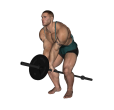 Reverse Row - Close Grip
Reverse Row - Close Grip
Benefits: This exercise is a strong, effective free weight back exercise for building muscle mass and size of the lats.
Purpose: This is a good exercise for increasing strength and size in the upper back.
Intermediate Traps Lats Triceps Posterior Delts Strength Barbell Pull Compound Gym
General Info: There are a number of muscles in the back, although the two major muscles are the lats and traps. The lats pulls the arm back and down towards the spine. The traps pull the shoulder blades back and towards the spine.
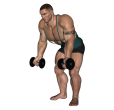 Reverse Row - Dumbbell
Reverse Row - Dumbbell
Benefits: This exercise is a strong, effective free weight back exercise for building muscle mass and size of the lats.
Purpose: This is a good exercise for increasing strength and size in the upper back.
Intermediate Traps Lats Triceps Posterior Delts Strength Dumbbell Pull Compound Gym
General Info: There are a number of muscles in the back, although the two major muscles are the lats and traps. The lats pulls the arm back and down towards the spine. The traps pull the shoulder blades back and towards the spine.
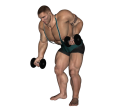 Reverse Row - Dumbbell Alternate
Reverse Row - Dumbbell Alternate
Benefits: This exercise is a strong, effective free weight back exercise for building muscle mass and size of the lats.
Purpose: This is a good exercise for increasing strength and size in the upper back.
Intermediate Traps Lats Triceps Posterior Delts Strength Dumbbell Pull Compound Gym
General Info: There are a number of muscles in the back, although the two major muscles are the lats and traps. The lats pulls the arm back and down towards the spine. The traps pull the shoulder blades back and towards the spine.
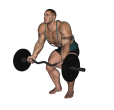 Reverse Row - EZ Bar
Reverse Row - EZ Bar
Benefits: This exercise is a strong, effective free weight back exercise for building muscle mass and size of the lats.
Purpose: This is a good exercise for increasing strength and size in the upper back.
Intermediate Traps Lats Triceps Posterior Delts Strength EZ Bar Pull Compound Gym
General Info: There are a number of muscles in the back, although the two major muscles are the lats and traps. The lats pulls the arm back and down towards the spine. The traps pull the shoulder blades back and towards the spine.
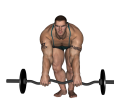 Reverse Row - EZ Bar Narrow Stance
Reverse Row - EZ Bar Narrow Stance
Benefits: This exercise is a strong, effective free weight back exercise for building muscle mass and size of the lats.
Purpose: This is a good exercise for increasing strength and size in the upper back.
Intermediate Traps Lats Triceps Posterior Delts Strength EZ Bar Pull Compound Gym
General Info: There are a number of muscles in the back, although the two major muscles are the lats and traps. The lats pulls the arm back and down towards the spine. The traps pull the shoulder blades back and towards the spine.
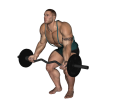 Reverse Row - EZ Bar Wide Grip
Reverse Row - EZ Bar Wide Grip
Benefits: This exercise is a strong, effective free weight back exercise for building muscle mass and size of the lats.
Purpose: This is a good exercise for increasing strength and size in the upper back.
Intermediate Traps Lats Triceps Posterior Delts Strength EZ Bar Pull Compound Gym
General Info: There are a number of muscles in the back, although the two major muscles are the lats and traps. The lats pulls the arm back and down towards the spine. The traps pull the shoulder blades back and towards the spine.
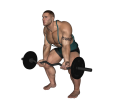 Reverse Row - EZ Bar Wide Stance
Reverse Row - EZ Bar Wide Stance
Benefits: This exercise is a strong, effective free weight back exercise for building muscle mass and size of the lats.
Purpose: This is a good exercise for increasing strength and size in the upper back.
Intermediate Traps Lats Triceps Posterior Delts Strength EZ Bar Pull Compound Gym
General Info: There are a number of muscles in the back, although the two major muscles are the lats and traps. The lats pulls the arm back and down towards the spine. The traps pull the shoulder blades back and towards the spine.
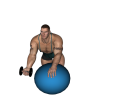 Reverse Row - Fitness Ball Dumbbell
Reverse Row - Fitness Ball Dumbbell
Benefits: This exercise is a strong, effective free weight back exercise for building muscle mass and size of the lats.
Purpose: This is a good exercise for increasing strength and size in the upper back.
Intermediate Traps Lats Triceps Posterior Delts Strength Dumbbell Fitness Ball Pull Compound Gym
General Info: There are a number of muscles in the back, although the two major muscles are the lats and traps. The lats pulls the arm back and down towards the spine. The traps pull the shoulder blades back and towards the spine.
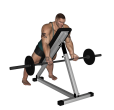 Reverse Row - Incline Barbell
Reverse Row - Incline Barbell
Benefits: This exercise is a strong, effective free weight back exercise for building muscle mass and size of the lats.
Purpose: This is a good exercise for increasing strength and size in the upper back.
Intermediate Traps Lats Triceps Posterior Delts Strength Barbell Incline Bench Pull Compound Gym
General Info: There are a number of muscles in the back, although the two major muscles are the lats and traps. The lats pulls the arm back and down towards the spine. The traps pull the shoulder blades back and towards the spine.
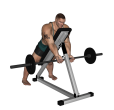 Reverse Row - Incline Barbell Close Grip
Reverse Row - Incline Barbell Close Grip
Benefits: This exercise is a strong, effective free weight back exercise for building muscle mass and size of the lats.
Purpose: This is a good exercise for increasing strength and size in the upper back.
Intermediate Traps Lats Triceps Posterior Delts Strength Barbell Incline Bench Pull Compound Gym
General Info: There are a number of muscles in the back, although the two major muscles are the lats and traps. The lats pulls the arm back and down towards the spine. The traps pull the shoulder blades back and towards the spine.
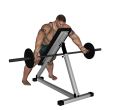 Reverse Row - Incline Barbell Wide
Reverse Row - Incline Barbell Wide
Benefits: This exercise is a strong, effective free weight back exercise for building muscle mass and size of the lats.
Purpose: This is a good exercise for increasing strength and size in the upper back.
Intermediate Traps Lats Triceps Posterior Delts Strength Barbell Incline Bench Pull Compound Gym
General Info: There are a number of muscles in the back, although the two major muscles are the lats and traps. The lats pulls the arm back and down towards the spine. The traps pull the shoulder blades back and towards the spine.
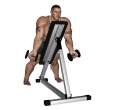 Reverse Row - Incline Dumbbell
Reverse Row - Incline Dumbbell
Benefits: This exercise is a strong, effective free weight back exercise for building muscle mass and size of the lats.
Purpose: This is a good exercise for increasing strength and size in the upper back.
Intermediate Traps Lats Triceps Posterior Delts Strength Dumbbell Incline Bench Pull Compound Gym
General Info: There are a number of muscles in the back, although the two major muscles are the lats and traps. The lats pulls the arm back and down towards the spine. The traps pull the shoulder blades back and towards the spine.
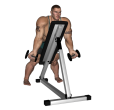 Reverse Row - Incline Dumbbell Alternate
Reverse Row - Incline Dumbbell Alternate
Benefits: This exercise is a strong, effective free weight back exercise for building muscle mass and size of the lats.
Purpose: This is a good exercise for increasing strength and size in the upper back.
Intermediate Traps Lats Triceps Posterior Delts Strength Dumbbell Incline Bench Pull Compound Gym
General Info: There are a number of muscles in the back, although the two major muscles are the lats and traps. The lats pulls the arm back and down towards the spine. The traps pull the shoulder blades back and towards the spine.
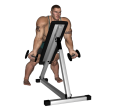 Reverse Row - Incline Dumbbell Alternate Variation
Reverse Row - Incline Dumbbell Alternate Variation
Benefits: This exercise is a strong, effective free weight back exercise for building muscle mass and size of the lats.
Purpose: This is a good exercise for increasing strength and size in the upper back.
Intermediate Traps Lats Triceps Posterior Delts Strength Dumbbell Incline Bench Pull Compound Gym
General Info: There are a number of muscles in the back, although the two major muscles are the lats and traps. The lats pulls the arm back and down towards the spine. The traps pull the shoulder blades back and towards the spine.
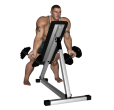 Reverse Row - Incline Dumbbell Single
Reverse Row - Incline Dumbbell Single
Benefits: This exercise is a strong, effective free weight back exercise for building muscle mass and size of the lats.
Purpose: This is a good exercise for increasing strength and size in the upper back.
Intermediate Traps Lats Triceps Posterior Delts Strength Dumbbell Incline Bench Pull Compound Gym
General Info: There are a number of muscles in the back, although the two major muscles are the lats and traps. The lats pulls the arm back and down towards the spine. The traps pull the shoulder blades back and towards the spine.
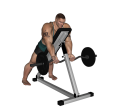 Reverse Row - Incline EZ Bar
Reverse Row - Incline EZ Bar
Benefits: This exercise is a strong, effective free weight back exercise for building muscle mass and size of the lats.
Purpose: This is a good exercise for increasing strength and size in the upper back.
Intermediate Traps Lats Triceps Posterior Delts Strength EZ Bar Incline Bench Pull Compound Gym
General Info: There are a number of muscles in the back, although the two major muscles are the lats and traps. The lats pulls the arm back and down towards the spine. The traps pull the shoulder blades back and towards the spine.
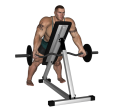 Reverse Row - Incline EZ Bar Wide Grip
Reverse Row - Incline EZ Bar Wide Grip
Benefits: This exercise is a strong, effective free weight back exercise for building muscle mass and size of the lats.
Purpose: This is a good exercise for increasing strength and size in the upper back.
Intermediate Traps Lats Triceps Posterior Delts Strength EZ Bar Incline Bench Pull Compound Gym
General Info: There are a number of muscles in the back, although the two major muscles are the lats and traps. The lats pulls the arm back and down towards the spine. The traps pull the shoulder blades back and towards the spine.
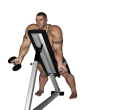 Reverse Row - Overhang Dumbbell
Reverse Row - Overhang Dumbbell
Benefits: This exercise is a strong, effective free weight back exercise for building muscle mass and size of the lats.
Purpose: This is a good exercise for increasing strength and size in the upper back.
Intermediate Traps Lats Triceps Posterior Delts Strength Dumbbell Incline Bench Pull Compound Gym
General Info: There are a number of muscles in the back, although the two major muscles are the lats and traps. The lats pulls the arm back and down towards the spine. The traps pull the shoulder blades back and towards the spine.
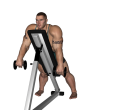 Reverse Row - Overhang Single Dumbbell
Reverse Row - Overhang Single Dumbbell
Benefits: This exercise is a strong, effective free weight back exercise for building muscle mass and size of the lats.
Purpose: This is a good exercise for increasing strength and size in the upper back.
Intermediate Traps Lats Triceps Posterior Delts Strength Dumbbell Incline Bench Pull Compound Gym
General Info: There are a number of muscles in the back, although the two major muscles are the lats and traps. The lats pulls the arm back and down towards the spine. The traps pull the shoulder blades back and towards the spine.
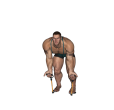 Reverse Row - Resistance Tube Bent Over
Reverse Row - Resistance Tube Bent Over
Benefits: This exercise is a strong, effective free weight back exercise for building muscle mass and size of the lats.
Purpose: This is a good exercise for increasing strength and size in the upper back.
Intermediate Traps Lats Triceps Posterior Delts Strength Resistance Tube Pull Compound Gym
General Info: There are a number of muscles in the back, although the two major muscles are the lats and traps. The lats pulls the arm back and down towards the spine. The traps pull the shoulder blades back and towards the spine.
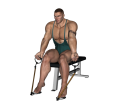 Reverse Row - Resistance Tube Seated
Reverse Row - Resistance Tube Seated
Benefits: This exercise is a strong, effective free weight back exercise for building muscle mass and size of the lats.
Purpose: This is a good exercise for increasing strength and size in the upper back.
Intermediate Traps Lats Posterior Delts Strength Resistance Tube Pull Compound Gym
General Info: There are a number of muscles in the back, although the two major muscles are the lats and traps. The lats pulls the arm back and down towards the spine. The traps pull the shoulder blades back and towards the spine.
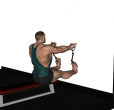 Reverse Row - Resistance Tube Seated Single
Reverse Row - Resistance Tube Seated Single
Benefits: This exercise is a strong, effective free weight back exercise for building muscle mass and size of the lats.
Purpose: This is a good exercise for increasing strength and size in the upper back.
Intermediate Traps Lats Posterior Delts Strength Resistance Tube Pull Compound Gym
General Info: There are a number of muscles in the back, although the two major muscles are the lats and traps. The lats pulls the arm back and down towards the spine. The traps pull the shoulder blades back and towards the spine.
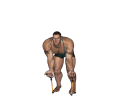 Reverse Row - Resistance Tube Single Bent Over
Reverse Row - Resistance Tube Single Bent Over
Benefits: This exercise is a strong, effective free weight back exercise for building muscle mass and size of the lats.
Purpose: This is a good exercise for increasing strength and size in the upper back.
Intermediate Traps Lats Triceps Posterior Delts Strength Resistance Tube Pull Compound Gym
General Info: There are a number of muscles in the back, although the two major muscles are the lats and traps. The lats pulls the arm back and down towards the spine. The traps pull the shoulder blades back and towards the spine.
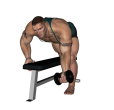 Reverse Row - Single Arm Dumbbell
Reverse Row - Single Arm Dumbbell
Benefits: This exercise is a strong, effective free weight back exercise for building muscle mass and size of the lats.
Purpose: This is a good exercise for increasing strength and size in the upper back.
Intermediate Traps Lats Triceps Posterior Delts Strength Dumbbell Flat Bench Pull Compound Gym
General Info: There are a number of muscles in the back, although the two major muscles are the lats and traps. The lats pulls the arm back and down towards the spine. The traps pull the shoulder blades back and towards the spine.
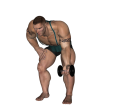 Reverse Row - Single Bent Knee Dumbbell
Reverse Row - Single Bent Knee Dumbbell
Benefits: This exercise is a strong, effective free weight back exercise for building muscle mass and size of the lats.
Purpose: This is a good exercise for increasing strength and size in the upper back.
Intermediate Traps Lats Triceps Posterior Delts Strength Dumbbell Pull Compound Gym
General Info: There are a number of muscles in the back, although the two major muscles are the lats and traps. The lats pulls the arm back and down towards the spine. The traps pull the shoulder blades back and towards the spine.
 Reverse Row - Single Bent Knee Water Bottle
Reverse Row - Single Bent Knee Water Bottle
Benefits: This exercise is a strong, effective free weight back exercise for building muscle mass and size of the lats.
Purpose: This is a good exercise for increasing strength and size in the upper back.
Intermediate Traps Lats Triceps Posterior Delts Strength Water Bottle Pull Compound Home
General Info: There are a number of muscles in the back, although the two major muscles are the lats and traps. The lats pulls the arm back and down towards the spine. The traps pull the shoulder blades back and towards the spine.
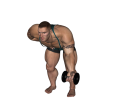 Reverse Row - Single Bent Over Dumbbell
Reverse Row - Single Bent Over Dumbbell
Benefits: This exercise is a strong, effective free weight back exercise for building muscle mass and size of the lats.
Purpose: This is a good exercise for increasing strength and size in the upper back.
Intermediate Traps Lats Triceps Posterior Delts Strength Dumbbell Pull Compound Gym
General Info: There are a number of muscles in the back, although the two major muscles are the lats and traps. The lats pulls the arm back and down towards the spine. The traps pull the shoulder blades back and towards the spine.
 Reverse Row - Single Bent Over Water Bottle
Reverse Row - Single Bent Over Water Bottle
Benefits: This exercise is a strong, effective free weight back exercise for building muscle mass and size of the lats.
Purpose: This is a good exercise for increasing strength and size in the upper back.
Intermediate Traps Lats Triceps Posterior Delts Strength Water Bottle Pull Compound Home
General Info: There are a number of muscles in the back, although the two major muscles are the lats and traps. The lats pulls the arm back and down towards the spine. The traps pull the shoulder blades back and towards the spine.
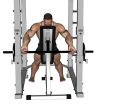 Reverse Row - Smith Incline Wide
Reverse Row - Smith Incline Wide
Benefits: This exercise is a strong, effective free weight back exercise for building muscle mass and size of the lats.
Purpose: This is a good exercise for increasing strength and size in the upper back.
Intermediate Traps Lats Triceps Posterior Delts Strength Smith Machine Incline Bench Pull Compound Gym
General Info: There are a number of muscles in the back, although the two major muscles are the lats and traps. The lats pulls the arm back and down towards the spine. The traps pull the shoulder blades back and towards the spine.
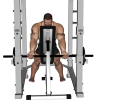 Reverse Row - Smith Machine Incline
Reverse Row - Smith Machine Incline
Benefits: This exercise is a strong, effective free weight back exercise for building muscle mass and size of the lats.
Purpose: This is a good exercise for increasing strength and size in the upper back.
Intermediate Traps Lats Triceps Posterior Delts Strength Smith Machine Incline Bench Pull Compound Gym
General Info: There are a number of muscles in the back, although the two major muscles are the lats and traps. The lats pulls the arm back and down towards the spine. The traps pull the shoulder blades back and towards the spine.
 Reverse Row - Water Bottle
Reverse Row - Water Bottle
Benefits: This exercise is a strong, effective free weight back exercise for building muscle mass and size of the lats.
Purpose: This is a good exercise for increasing strength and size in the upper back.
Intermediate Traps Lats Triceps Posterior Delts Strength Water Bottle Pull Compound Home
General Info: There are a number of muscles in the back, although the two major muscles are the lats and traps. The lats pulls the arm back and down towards the spine. The traps pull the shoulder blades back and towards the spine.
 Reverse Row - Water Bottle Alternate
Reverse Row - Water Bottle Alternate
Benefits: This exercise is a strong, effective free weight back exercise for building muscle mass and size of the lats.
Purpose: This is a good exercise for increasing strength and size in the upper back.
Intermediate Traps Lats Triceps Posterior Delts Strength Water Bottle Pull Compound Home
General Info: There are a number of muscles in the back, although the two major muscles are the lats and traps. The lats pulls the arm back and down towards the spine. The traps pull the shoulder blades back and towards the spine.
 Rickshaw Carry - Basic
Rickshaw Carry - Basic
Benefits: This exercise involves many other muscles.
Purpose: This exercise builds overall strength in the lower body.
Lower Back Glutes Hamstrings Calves Quads Forearms Lats Middle Back Traps Strength Rickshaw Apparatus Pull Compound Gym
General Info: The muscles of the lower back straighten the spine. They work together with the abdominals to keep the spine upright. The Barbell Deadlift is considered to be the king of exercises. No other exercise will work your body so much.
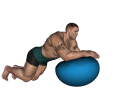 Roll Out - Fitness Ball
Roll Out - Fitness Ball
Benefits: This exercise will give you a well-defined mid-section.
Purpose: This exercise strengthens the abdominal muscles.
Intermediate Abdominals Shoulders Strength Fitness Ball Pull Compound Gym
General Info: The abs can be divided into the abdominals themselves and the obliques. The obliques are the outer abs and are used in twisting movements. For the sake of exercising, the abdominals are sometimes divided into upper abs and lower abs (this is not a technical division but something for exercising). Both upper and lower abs are used in straight line ab exercises while the upper abs are also involved in twisting movements.
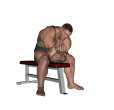 Rotational Flexibility - Wrist Tendons 1
Rotational Flexibility - Wrist Tendons 1
Benefits: This exercise focuses on wrist flexibility.
Purpose: This exercise rotates the wrist to increase flexibility.
Beginner Forearms Strength Body Only Pull Gym
General Info: A complete forearm program must achieve balanced development for all major forearm muscles. The forearm is involved in six different forearm movements. They include wrist flexion, wrist extension, wrist abduction, wrist adduction, forearm pronation, and forearm supination. There are additional muscles found in the forearm that are involved in movements like elbow flexion (brachioradialis), finger flexion, and finger extension.
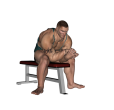 Rotational Flexibility - Wrist Tendons 2
Rotational Flexibility - Wrist Tendons 2
Benefits: This exercise focuses on wrist flexibility.
Purpose: This exercise rotates the wrist to increase flexibility.
Beginner Forearms Strength Body Only Pull Gym
General Info: A complete forearm program must achieve balanced development for all major forearm muscles. The forearm is involved in six different forearm movements. They include wrist flexion, wrist extension, wrist abduction, wrist adduction, forearm pronation, and forearm supination. There are additional muscles found in the forearm that are involved in movements like elbow flexion (brachioradialis), finger flexion, and finger extension.
 Row - Basic Water Bottle
Row - Basic Water Bottle
Benefits: This exercise is a strong, effective free weight back exercise for building muscle mass and size of the lats.
Purpose: This is a good exercise for increasing strength and size in the upper back.
Intermediate Traps Lats Triceps Posterior Delts Strength Water Bottle Pull Compound Home
General Info: There are a number of muscles in the back, although the two major muscles are the lats and traps. The lats pulls the arm back and down towards the spine. The traps pull the shoulder blades back and towards the spine.
 Row - Basic Water Bottle Alternate
Row - Basic Water Bottle Alternate
Benefits: This exercise is a strong, effective free weight back exercise for building muscle mass and size of the lats.
Purpose: This is a good exercise for increasing strength and size in the upper back.
Intermediate Traps Lats Triceps Posterior Delts Strength Water Bottle Pull Compound Home
General Info: There are a number of muscles in the back, although the two major muscles are the lats and traps. The lats pulls the arm back and down towards the spine. The traps pull the shoulder blades back and towards the spine.
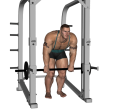 Row - Bent Knee Smith Machine
Row - Bent Knee Smith Machine
Benefits: This exercise is a strong, effective free weight back exercise for building muscle mass and size of the lats.
Purpose: This is a good exercise for increasing strength and size in the upper back.
Intermediate Traps Lats Triceps Posterior Delts Strength Smith Machine Pull Compound Gym
General Info: There are a number of muscles in the back, although the two major muscles are the lats and traps. The lats pulls the arm back and down towards the spine. The traps pull the shoulder blades back and towards the spine.
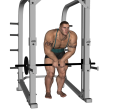 Row - Bent Knee Smith Machine Close
Row - Bent Knee Smith Machine Close
Benefits: This exercise is a strong, effective free weight back exercise for building muscle mass and size of the lats.
Purpose: This is a good exercise for increasing strength and size in the upper back.
Intermediate Traps Lats Triceps Posterior Delts Strength Smith Machine Pull Compound Gym
General Info: There are a number of muscles in the back, although the two major muscles are the lats and traps. The lats pulls the arm back and down towards the spine. The traps pull the shoulder blades back and towards the spine.
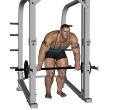 Row - Bent Knee Smith Machine Wide
Row - Bent Knee Smith Machine Wide
Benefits: This exercise is a strong, effective free weight back exercise for building muscle mass and size of the lats.
Purpose: This is a good exercise for increasing strength and size in the upper back.
Intermediate Traps Lats Triceps Posterior Delts Strength Smith Machine Pull Compound Gym
General Info: There are a number of muscles in the back, although the two major muscles are the lats and traps. The lats pulls the arm back and down towards the spine. The traps pull the shoulder blades back and towards the spine.
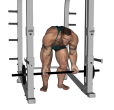 Row - Bent Over Smith Machine
Row - Bent Over Smith Machine
Benefits: This exercise is a strong, effective free weight back exercise for building muscle mass and size of the lats.
Purpose: This is a good exercise for increasing strength and size in the upper back.
Intermediate Traps Lats Triceps Posterior Delts Strength Smith Machine Pull Compound Gym
General Info: There are a number of muscles in the back, although the two major muscles are the lats and traps. The lats pulls the arm back and down towards the spine. The traps pull the shoulder blades back and towards the spine.
 Row - Bent Over Smith Machine Close
Row - Bent Over Smith Machine Close
Benefits: This exercise is a strong, effective free weight back exercise for building muscle mass and size of the lats.
Purpose: This is a good exercise for increasing strength and size in the upper back.
Intermediate Traps Lats Triceps Posterior Delts Strength Smith Machine Pull Compound Gym
General Info: There are a number of muscles in the back, although the two major muscles are the lats and traps. The lats pulls the arm back and down towards the spine. The traps pull the shoulder blades back and towards the spine.
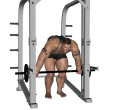 Row - Bent Over Smith Machine Wide
Row - Bent Over Smith Machine Wide
Benefits: This exercise is a strong, effective free weight back exercise for building muscle mass and size of the lats.
Purpose: This is a good exercise for increasing strength and size in the upper back.
Intermediate Traps Lats Triceps Posterior Delts Strength Smith Machine Pull Compound Gym
General Info: There are a number of muscles in the back, although the two major muscles are the lats and traps. The lats pulls the arm back and down towards the spine. The traps pull the shoulder blades back and towards the spine.
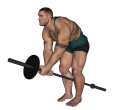 Row - Bent Over Two Arm Long Bar
Row - Bent Over Two Arm Long Bar
Benefits: This exercise is a strong, effective free weight back exercise for building muscle mass and size of the lats.
Purpose: This is a good exercise for increasing strength and size in the upper back.
Intermediate Traps Lats Triceps Posterior Delts Strength Long Bar Pull Compound Gym
General Info: There are a number of muscles in the back, although the two major muscles are the lats and traps. The lats pulls the arm back and down towards the spine. The traps pull the shoulder blades back and towards the spine.
 Row - Bent Over Water Bottle
Row - Bent Over Water Bottle
Benefits: This exercise is a strong, effective free weight back exercise for building muscle mass and size of the lats.
Purpose: This is a good exercise for increasing strength and size in the upper back.
Intermediate Traps Lats Triceps Posterior Delts Strength Water Bottle Pull Compound Home
General Info: There are a number of muscles in the back, although the two major muscles are the lats and traps. The lats pulls the arm back and down towards the spine. The traps pull the shoulder blades back and towards the spine.
 Row - Bent Over Water Bottle Alternate
Row - Bent Over Water Bottle Alternate
Benefits: This exercise is a strong, effective free weight back exercise for building muscle mass and size of the lats.
Purpose: This is a good exercise for increasing strength and size in the upper back.
Intermediate Traps Lats Triceps Posterior Delts Strength Water Bottle Pull Compound Home
General Info: There are a number of muscles in the back, although the two major muscles are the lats and traps. The lats pulls the arm back and down towards the spine. The traps pull the shoulder blades back and towards the spine.
 Row - Bent Over Water Bottle Close Alternate
Row - Bent Over Water Bottle Close Alternate
Benefits: This exercise is a strong, effective free weight back exercise for building muscle mass and size of the lats.
Purpose: This is a good exercise for increasing strength and size in the upper back.
Intermediate Traps Lats Triceps Posterior Delts Strength Water Bottle Pull Compound Home
General Info: There are a number of muscles in the back, although the two major muscles are the lats and traps. The lats pulls the arm back and down towards the spine. The traps pull the shoulder blades back and towards the spine.
 Row - Bent Over Water Bottle Dual
Row - Bent Over Water Bottle Dual
Benefits: This exercise is a strong, effective free weight back exercise for building muscle mass and size of the lats.
Purpose: This is a good exercise for increasing strength and size in the upper back.
Beginner Traps Lats Triceps Posterior Delts Strength Water Bottle Pull Compound Home
General Info: There are a number of muscles in the back, although the two major muscles are the lats and traps. The lats pulls the arm back and down towards the spine. The traps pull the shoulder blades back and towards the spine.
 Row - Bent Over Water Bottle Inwards
Row - Bent Over Water Bottle Inwards
Benefits: This exercise is a strong, effective free weight back exercise for building muscle mass and size of the lats.
Purpose: This is a good exercise for increasing strength and size in the upper back.
Intermediate Traps Lats Triceps Posterior Delts Strength Water Bottle Pull Compound Home
General Info: There are a number of muscles in the back, although the two major muscles are the lats and traps. The lats pulls the arm back and down towards the spine. The traps pull the shoulder blades back and towards the spine.
 Row - Bent Over Water Bottle Inwards Alternate
Row - Bent Over Water Bottle Inwards Alternate
Benefits: This exercise is a strong, effective free weight back exercise for building muscle mass and size of the lats.
Purpose: This is a good exercise for increasing strength and size in the upper back.
Intermediate Traps Lats Triceps Posterior Delts Strength Water Bottle Pull Compound Home
General Info: There are a number of muscles in the back, although the two major muscles are the lats and traps. The lats pulls the arm back and down towards the spine. The traps pull the shoulder blades back and towards the spine.
 Row - Bent Over Water Bottle Narrow
Row - Bent Over Water Bottle Narrow
Benefits: This exercise is a strong, effective free weight back exercise for building muscle mass and size of the lats.
Purpose: This is a good exercise for increasing strength and size in the upper back.
Intermediate Traps Lats Triceps Posterior Delts Strength Water Bottle Pull Compound Home
General Info: There are a number of muscles in the back, although the two major muscles are the lats and traps. The lats pulls the arm back and down towards the spine. The traps pull the shoulder blades back and towards the spine.
 Row - Bent Over Water Bottle Palms In
Row - Bent Over Water Bottle Palms In
Benefits: This exercise is a strong, effective free weight back exercise for building muscle mass and size of the lats.
Purpose: This is a good exercise for increasing strength and size in the upper back.
Intermediate Traps Lats Triceps Posterior Delts Strength Water Bottle Pull Compound Home
General Info: There are a number of muscles in the back, although the two major muscles are the lats and traps. The lats pulls the arm back and down towards the spine. The traps pull the shoulder blades back and towards the spine.
 Row - Bent Over Water Bottle Rotation
Row - Bent Over Water Bottle Rotation
Benefits: This exercise is a strong, effective free weight back exercise for building muscle mass and size of the lats.
Purpose: This is a good exercise for increasing strength and size in the upper back.
Intermediate Traps Lats Triceps Posterior Delts Strength Water Bottle Pull Compound Home
General Info: There are a number of muscles in the back, although the two major muscles are the lats and traps. The lats pulls the arm back and down towards the spine. The traps pull the shoulder blades back and towards the spine.
 Row - Bent Water Bottle Rotation Alternate
Row - Bent Water Bottle Rotation Alternate
Benefits: This exercise is a strong, effective free weight back exercise for building muscle mass and size of the lats.
Purpose: This is a good exercise for increasing strength and size in the upper back.
Intermediate Traps Lats Triceps Posterior Delts Strength Water Bottle Pull Compound Home
General Info: There are a number of muscles in the back, although the two major muscles are the lats and traps. The lats pulls the arm back and down towards the spine. The traps pull the shoulder blades back and towards the spine.
 Row - Bent Water Bottle Single Inwards
Row - Bent Water Bottle Single Inwards
Benefits: This exercise is a strong, effective free weight back exercise for building muscle mass and size of the lats.
Purpose: This is a good exercise for increasing strength and size in the upper back.
Intermediate Traps Lats Triceps Posterior Delts Strength Water Bottle Pull Compound Home
General Info: There are a number of muscles in the back, although the two major muscles are the lats and traps. The lats pulls the arm back and down towards the spine. The traps pull the shoulder blades back and towards the spine.
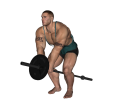 Row - Close Grip
Row - Close Grip
Benefits: This exercise is a strong, effective free weight back exercise for building muscle mass and size of the lats.
Purpose: This is a good exercise for increasing strength and size in the upper back.
Intermediate Traps Lats Triceps Posterior Delts Strength Barbell Pull Compound Gym
General Info: There are a number of muscles in the back, although the two major muscles are the lats and traps. The lats pulls the arm back and down towards the spine. The traps pull the shoulder blades back and towards the spine.
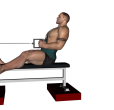 Row - Elevated Cable
Row - Elevated Cable
Benefits: This exercise is a strong, effective free weight back exercise for building muscle mass and size of the lats.
Purpose: This is a good exercise for increasing strength and size in the upper back.
Intermediate Traps Lats Posterior Delts Strength Cable Machine Pull Compound Gym
General Info: There are a number of muscles in the back, although the two major muscles are the lats and traps. The lats pulls the arm back and down towards the spine. The traps pull the shoulder blades back and towards the spine.
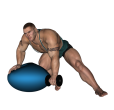 Row - Fitness Ball Single Arm
Row - Fitness Ball Single Arm
Benefits: This exercise is a strong, effective free weight back exercise for building muscle mass and size of the lats.
Purpose: This is a good exercise for increasing strength and size in the upper back.
Intermediate Traps Lats Triceps Posterior Delts Strength Dumbbell Fitness Ball Pull Compound Gym
General Info: There are a number of muscles in the back, although the two major muscles are the lats and traps. The lats pulls the arm back and down towards the spine. The traps pull the shoulder blades back and towards the spine.
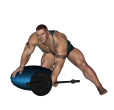 Row - Fitness Ball Single Arm Barbell
Row - Fitness Ball Single Arm Barbell
Benefits: This exercise is a strong, effective free weight back exercise for building muscle mass and size of the lats.
Purpose: This is a good exercise for increasing strength and size in the upper back.
Intermediate Traps Lats Triceps Posterior Delts Strength Barbell Fitness Ball Pull Compound Gym
General Info: There are a number of muscles in the back, although the two major muscles are the lats and traps. The lats pulls the arm back and down towards the spine. The traps pull the shoulder blades back and towards the spine.
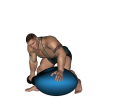 Row - Fitness Ball Single Arm Dumbbell
Row - Fitness Ball Single Arm Dumbbell
Benefits: This exercise is a strong, effective free weight back exercise for building muscle mass and size of the lats.
Purpose: This is a good exercise for increasing strength and size in the upper back.
Intermediate Traps Lats Triceps Posterior Delts Strength Dumbbell Fitness Ball Pull Compound Gym
General Info: There are a number of muscles in the back, although the two major muscles are the lats and traps. The lats pulls the arm back and down towards the spine. The traps pull the shoulder blades back and towards the spine.
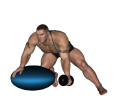 Row - Fitness Ball Single Arm Inwards
Row - Fitness Ball Single Arm Inwards
Benefits: This exercise is a strong, effective free weight back exercise for building muscle mass and size of the lats.
Purpose: This is a good exercise for increasing strength and size in the upper back.
Intermediate Traps Lats Triceps Posterior Delts Strength Dumbbell Fitness Ball Pull Compound Gym
General Info: There are a number of muscles in the back, although the two major muscles are the lats and traps. The lats pulls the arm back and down towards the spine. The traps pull the shoulder blades back and towards the spine.
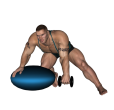 Row - Fitness Ball Single Arm Rotation
Row - Fitness Ball Single Arm Rotation
Benefits: This exercise is a strong, effective free weight back exercise for building muscle mass and size of the lats.
Purpose: This is a good exercise for increasing strength and size in the upper back.
Intermediate Traps Lats Triceps Posterior Delts Strength Dumbbell Fitness Ball Pull Compound Gym
General Info: There are a number of muscles in the back, although the two major muscles are the lats and traps. The lats pulls the arm back and down towards the spine. The traps pull the shoulder blades back and towards the spine.
 Row - Inwards Water Bottle
Row - Inwards Water Bottle
Benefits: This exercise is a strong, effective free weight back exercise for building muscle mass and size of the lats.
Purpose: This is a good exercise for increasing strength and size in the upper back.
Intermediate Traps Lats Triceps Posterior Delts Strength Water Bottle Pull Compound Home
General Info: There are a number of muscles in the back, although the two major muscles are the lats and traps. The lats pulls the arm back and down towards the spine. The traps pull the shoulder blades back and towards the spine.
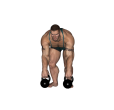 Row - Kettlebell
Row - Kettlebell
Benefits: This exercise is a strong, effective free weight back exercise for building muscle mass and size of the lats.
Purpose: This is a good exercise for increasing strength and size in the upper back.
Intermediate Traps Lats Triceps Posterior Delts Strength Kettlebell Pull Compound Gym
General Info: There are a number of muscles in the back, although the two major muscles are the lats and traps. The lats pulls the arm back and down towards the spine. The traps pull the shoulder blades back and towards the spine.
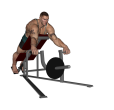 Row - Lying T Bar
Row - Lying T Bar
Benefits: This exercise is a strong, effective free weight back exercise for building muscle mass and size of the lats.
Purpose: This is a good exercise for increasing strength and size in the upper back.
Intermediate Traps Lats Triceps Posterior Delts Strength T-Bar Pull Compound Gym
General Info: There are a number of muscles in the back, although the two major muscles are the lats and traps. The lats pulls the arm back and down towards the spine. The traps pull the shoulder blades back and towards the spine.
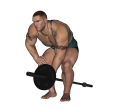 Row - One Arm Long Bar
Row - One Arm Long Bar
Benefits: This exercise is a strong, effective free weight back exercise for building muscle mass and size of the lats.
Purpose: This is a good exercise for increasing strength and size in the upper back.
Intermediate Traps Lats Triceps Posterior Delts Strength Barbell Pull Compound Gym
General Info: There are a number of muscles in the back, although the two major muscles are the lats and traps. The lats pulls the arm back and down towards the spine. The traps pull the shoulder blades back and towards the spine.
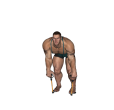 Row - Resistance Tube Bent Over
Row - Resistance Tube Bent Over
Benefits: This exercise is a strong, effective free weight back exercise for building muscle mass and size of the lats.
Purpose: This is a good exercise for increasing strength and size in the upper back.
Intermediate Traps Lats Triceps Posterior Delts Strength Resistance Tube Pull Compound Gym
General Info: There are a number of muscles in the back, although the two major muscles are the lats and traps. The lats pulls the arm back and down towards the spine. The traps pull the shoulder blades back and towards the spine.
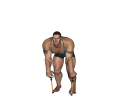 Row - Resistance Tube Bent Over Alternate
Row - Resistance Tube Bent Over Alternate
Benefits: This exercise is a strong, effective free weight back exercise for building muscle mass and size of the lats.
Purpose: This is a good exercise for increasing strength and size in the upper back.
Intermediate Traps Lats Triceps Posterior Delts Strength Resistance Tube Pull Compound Gym
General Info: There are a number of muscles in the back, although the two major muscles are the lats and traps. The lats pulls the arm back and down towards the spine. The traps pull the shoulder blades back and towards the spine.
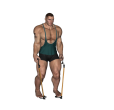 Row - Resistance Tube Inwards
Row - Resistance Tube Inwards
Benefits: This exercise is a strong, effective free weight back exercise for building muscle mass and size of the lats.
Purpose: This is a good exercise for increasing strength and size in the upper back.
Intermediate Traps Lats Triceps Posterior Delts Strength Resistance Tube Pull Compound Gym
General Info: There are a number of muscles in the back, although the two major muscles are the lats and traps. The lats pulls the arm back and down towards the spine. The traps pull the shoulder blades back and towards the spine.
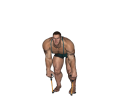 Row - Resistance Tube Rotation
Row - Resistance Tube Rotation
Benefits: This exercise is a strong, effective free weight back exercise for building muscle mass and size of the lats.
Purpose: This is a good exercise for increasing strength and size in the upper back.
Intermediate Traps Lats Triceps Posterior Delts Strength Resistance Tube Pull Compound Gym
General Info: There are a number of muscles in the back, although the two major muscles are the lats and traps. The lats pulls the arm back and down towards the spine. The traps pull the shoulder blades back and towards the spine.
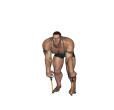 Row - Resistance Tube Rotation Alternate
Row - Resistance Tube Rotation Alternate
Benefits: This exercise is a strong, effective free weight back exercise for building muscle mass and size of the lats.
Purpose: This is a good exercise for increasing strength and size in the upper back.
Intermediate Traps Lats Triceps Posterior Delts Strength Resistance Tube Pull Compound Gym
General Info: There are a number of muscles in the back, although the two major muscles are the lats and traps. The lats pulls the arm back and down towards the spine. The traps pull the shoulder blades back and towards the spine.
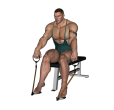 Row - Resistance Tube Seated
Row - Resistance Tube Seated
Benefits: This exercise is a strong, effective free weight back exercise for building muscle mass and size of the lats.
Purpose: This is a good exercise for increasing strength and size in the upper back.
Intermediate Traps Lats Posterior Delts Strength Resistance Tube Pull Compound Gym
General Info: There are a number of muscles in the back, although the two major muscles are the lats and traps. The lats pulls the arm back and down towards the spine. The traps pull the shoulder blades back and towards the spine.
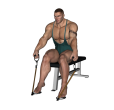 Row - Resistance Tube Seated Inwards
Row - Resistance Tube Seated Inwards
Benefits: This exercise is a strong, effective free weight back exercise for building muscle mass and size of the lats.
Purpose: This is a good exercise for increasing strength and size in the upper back.
Intermediate Traps Lats Posterior Delts Strength Resistance Tube Pull Compound Gym
General Info: There are a number of muscles in the back, although the two major muscles are the lats and traps. The lats pulls the arm back and down towards the spine. The traps pull the shoulder blades back and towards the spine.
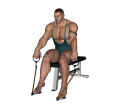 Row - Resistance Tube Seated Rotation
Row - Resistance Tube Seated Rotation
Benefits: This exercise is a strong, effective free weight back exercise for building muscle mass and size of the lats.
Purpose: This is a good exercise for increasing strength and size in the upper back.
Intermediate Traps Lats Posterior Delts Strength Resistance Tube Pull Compound Gym
General Info: There are a number of muscles in the back, although the two major muscles are the lats and traps. The lats pulls the arm back and down towards the spine. The traps pull the shoulder blades back and towards the spine.
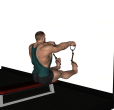 Row - Resistance Tube Seated Single
Row - Resistance Tube Seated Single
Benefits: This exercise is a strong, effective free weight back exercise for building muscle mass and size of the lats.
Purpose: This is a good exercise for increasing strength and size in the upper back.
Intermediate Traps Lats Posterior Delts Strength Resistance Tube Pull Compound Gym
General Info: There are a number of muscles in the back, although the two major muscles are the lats and traps. The lats pulls the arm back and down towards the spine. The traps pull the shoulder blades back and towards the spine.
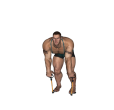 Row - Resistance Tube Single Bent Over
Row - Resistance Tube Single Bent Over
Benefits: This exercise is a strong, effective free weight back exercise for building muscle mass and size of the lats.
Purpose: This is a good exercise for increasing strength and size in the upper back.
Intermediate Traps Lats Triceps Posterior Delts Strength Resistance Tube Pull Compound Gym
General Info: There are a number of muscles in the back, although the two major muscles are the lats and traps. The lats pulls the arm back and down towards the spine. The traps pull the shoulder blades back and towards the spine.
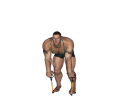 Row - Resistance Tube Single Rotation
Row - Resistance Tube Single Rotation
Benefits: This exercise is a strong, effective free weight back exercise for building muscle mass and size of the lats.
Purpose: This is a good exercise for increasing strength and size in the upper back.
Intermediate Traps Lats Triceps Posterior Delts Strength Resistance Tube Pull Compound Gym
General Info: There are a number of muscles in the back, although the two major muscles are the lats and traps. The lats pulls the arm back and down towards the spine. The traps pull the shoulder blades back and towards the spine.
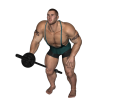 Row - Single Arm Barbell Variation
Row - Single Arm Barbell Variation
Benefits: This exercise is a strong, effective free weight back exercise for building muscle mass and size of the lats.
Purpose: This is a good exercise for increasing strength and size in the upper back.
Intermediate Traps Lats Triceps Posterior Delts Strength Barbell Pull Compound Gym
General Info: There are a number of muscles in the back, although the two major muscles are the lats and traps. The lats pulls the arm back and down towards the spine. The traps pull the shoulder blades back and towards the spine.
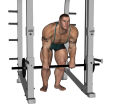 Row - Smith Machine
Row - Smith Machine
Benefits: This exercise is a strong, effective free weight back exercise for building muscle mass and size of the lats.
Purpose: This is a good exercise for increasing strength and size in the upper back.
Intermediate Traps Lats Triceps Posterior Delts Strength Smith Machine Pull Compound Gym
General Info: There are a number of muscles in the back, although the two major muscles are the lats and traps. The lats pulls the arm back and down towards the spine. The traps pull the shoulder blades back and towards the spine.
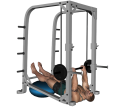 Row - Smith Machine Ball Inverted
Row - Smith Machine Ball Inverted
Benefits: This exercise is a strong, effective free weight back exercise for building muscle mass and size of the lats.
Purpose: This is a good exercise for increasing strength and size in the upper back.
Intermediate Traps Lats Triceps Posterior Delts Strength Smith Machine Fitness Ball Pull Compound Gym
General Info: There are a number of muscles in the back, although the two major muscles are the lats and traps. The lats pulls the arm back and down towards the spine. The traps pull the shoulder blades back and towards the spine.
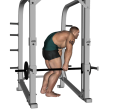 Row - Smith Machine Bent Knee Single Arm
Row - Smith Machine Bent Knee Single Arm
Benefits: This exercise is a strong, effective free weight back exercise for building muscle mass and size of the lats.
Purpose: This is a good exercise for increasing strength and size in the upper back.
Intermediate Traps Lats Triceps Posterior Delts Strength Smith Machine Pull Compound Gym
General Info: There are a number of muscles in the back, although the two major muscles are the lats and traps. The lats pulls the arm back and down towards the spine. The traps pull the shoulder blades back and towards the spine.
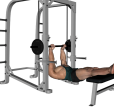 Row - Smith Machine High Inverted
Row - Smith Machine High Inverted
Benefits: This exercise is a strong, effective free weight back exercise for building muscle mass and size of the lats.
Purpose: This is a good exercise for increasing strength and size in the upper back.
Intermediate Traps Lats Triceps Posterior Delts Strength Smith Machine Flat Bench Pull Compound Gym
General Info: There are a number of muscles in the back, although the two major muscles are the lats and traps. The lats pulls the arm back and down towards the spine. The traps pull the shoulder blades back and towards the spine.
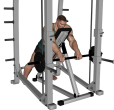 Row - Smith Machine Incline
Row - Smith Machine Incline
Benefits: This exercise is a strong, effective free weight back exercise for building muscle mass and size of the lats.
Purpose: This is a good exercise for increasing strength and size in the upper back.
Intermediate Traps Lats Triceps Posterior Delts Strength Smith Machine Incline Bench Pull Compound Gym
General Info: There are a number of muscles in the back, although the two major muscles are the lats and traps. The lats pulls the arm back and down towards the spine. The traps pull the shoulder blades back and towards the spine.
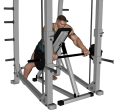 Row - Smith Machine Incline Wide
Row - Smith Machine Incline Wide
Benefits: This exercise is a strong, effective free weight back exercise for building muscle mass and size of the lats.
Purpose: This is a good exercise for increasing strength and size in the upper back.
Intermediate Traps Lats Triceps Posterior Delts Strength Smith Machine Incline Bench Pull Compound Gym
General Info: There are a number of muscles in the back, although the two major muscles are the lats and traps. The lats pulls the arm back and down towards the spine. The traps pull the shoulder blades back and towards the spine.
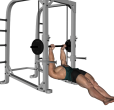 Row - Smith Machine Lying Inverted
Row - Smith Machine Lying Inverted
Benefits: This exercise is a strong, effective free weight back exercise for building muscle mass and size of the lats.
Purpose: This is a good exercise for increasing strength and size in the upper back.
Intermediate Traps Lats Triceps Posterior Delts Strength Smith Machine Pull Compound Gym
General Info: There are a number of muscles in the back, although the two major muscles are the lats and traps. The lats pulls the arm back and down towards the spine. The traps pull the shoulder blades back and towards the spine.
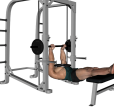 Row - Smith Machine Plate Inverted
Row - Smith Machine Plate Inverted
Benefits: This exercise is a strong, effective free weight back exercise for building muscle mass and size of the lats.
Purpose: This is a good exercise for increasing strength and size in the upper back.
Intermediate Traps Lats Triceps Posterior Delts Strength Smith Machine Flat Bench Plate Pull Compound Gym
General Info: There are a number of muscles in the back, although the two major muscles are the lats and traps. The lats pulls the arm back and down towards the spine. The traps pull the shoulder blades back and towards the spine.
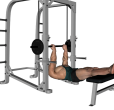 Row - Smith Reverse Grip High Inverted
Row - Smith Reverse Grip High Inverted
Benefits: This exercise is a strong, effective free weight back exercise for building muscle mass and size of the lats.
Purpose: This is a good exercise for increasing strength and size in the upper back.
Intermediate Traps Lats Triceps Posterior Delts Strength Smith Machine Flat Bench Pull Compound Gym
General Info: There are a number of muscles in the back, although the two major muscles are the lats and traps. The lats pulls the arm back and down towards the spine. The traps pull the shoulder blades back and towards the spine.
 Row - Smith Reverse Grip Inverted
Row - Smith Reverse Grip Inverted
Benefits: This exercise is a strong, effective free weight back exercise for building muscle mass and size of the lats.
Purpose: This is a good exercise for increasing strength and size in the upper back.
Intermediate Traps Lats Triceps Posterior Delts Strength Smith Machine Pull Compound Gym
General Info: There are a number of muscles in the back, although the two major muscles are the lats and traps. The lats pulls the arm back and down towards the spine. The traps pull the shoulder blades back and towards the spine.
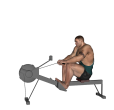 Row - Stationary
Row - Stationary
Benefits: Stationary rowing is an excellent overall exercise.
Purpose: This exercise improves cardio fitness.
Intermediate Quads Back Biceps Shoulders Cardio Rowing Machine Gym
General Info: Research has shown that people who spend long periods of time jogging, on treadmills, jumping rope, or stationary bikes, at a relative constant rate of speed, actually lose heart size and fitness. In addition, the body stores more fat to ensure that it can meet the demands of this marathon. But those who do short bursts (1-5 minutes) of intensive exercising and then cool down for another 2-5 minutes have better heart fitness and the muscles of their heart are stronger. Short bursts of intensive exercising have another benefit. The body actually burns more fat and continues to do it for 2-4 hours after the exercise has been completed. This means that your metabolic rate is higher and you will lose fat and be slimmer.
 Row - Tube Seated Inwards Single
Row - Tube Seated Inwards Single
Benefits: This exercise is a strong, effective free weight back exercise for building muscle mass and size of the lats.
Purpose: This is a good exercise for increasing strength and size in the upper back.
Intermediate Traps Lats Posterior Delts Strength Resistance Tube Pull Compound Gym
General Info: There are a number of muscles in the back, although the two major muscles are the lats and traps. The lats pulls the arm back and down towards the spine. The traps pull the shoulder blades back and towards the spine.
 Row - Tube Single Bent Over Inwards
Row - Tube Single Bent Over Inwards
Benefits: This exercise is a strong, effective free weight back exercise for building muscle mass and size of the lats.
Purpose: This is a good exercise for increasing strength and size in the upper back.
Intermediate Traps Lats Triceps Posterior Delts Strength Resistance Tube Pull Compound Gym
General Info: There are a number of muscles in the back, although the two major muscles are the lats and traps. The lats pulls the arm back and down towards the spine. The traps pull the shoulder blades back and towards the spine.
 Row - Water Bottle Inwards Alternate
Row - Water Bottle Inwards Alternate
Benefits: This exercise is a strong, effective free weight back exercise for building muscle mass and size of the lats.
Purpose: This is a good exercise for increasing strength and size in the upper back.
Intermediate Traps Lats Triceps Posterior Delts Strength Water Bottle Pull Compound Home
General Info: There are a number of muscles in the back, although the two major muscles are the lats and traps. The lats pulls the arm back and down towards the spine. The traps pull the shoulder blades back and towards the spine.
 Row - Water Bottle Rotation
Row - Water Bottle Rotation
Benefits: This exercise is a strong, effective free weight back exercise for building muscle mass and size of the lats.
Purpose: This is a good exercise for increasing strength and size in the upper back.
Intermediate Traps Lats Triceps Posterior Delts Strength Water Bottle Pull Compound Home
General Info: There are a number of muscles in the back, although the two major muscles are the lats and traps. The lats pulls the arm back and down towards the spine. The traps pull the shoulder blades back and towards the spine.
 Row - Water Bottle Rotation Alternate
Row - Water Bottle Rotation Alternate
Benefits: This exercise is a strong, effective free weight back exercise for building muscle mass and size of the lats.
Purpose: This is a good exercise for increasing strength and size in the upper back.
Intermediate Traps Lats Triceps Posterior Delts Strength Water Bottle Pull Compound Home
General Info: There are a number of muscles in the back, although the two major muscles are the lats and traps. The lats pulls the arm back and down towards the spine. The traps pull the shoulder blades back and towards the spine.
 Row - Water Bottle Single Bent Over
Row - Water Bottle Single Bent Over
Benefits: This exercise is a strong, effective free weight back exercise for building muscle mass and size of the lats.
Purpose: This is a good exercise for increasing strength and size in the upper back.
Intermediate Traps Lats Triceps Posterior Delts Strength Water Bottle Pull Compound Home
General Info: There are a number of muscles in the back, although the two major muscles are the lats and traps. The lats pulls the arm back and down towards the spine. The traps pull the shoulder blades back and towards the spine.
 Row - Water Bottle Single Bent Over Rotation
Row - Water Bottle Single Bent Over Rotation
Benefits: This exercise is a strong, effective free weight back exercise for building muscle mass and size of the lats.
Purpose: This is a good exercise for increasing strength and size in the upper back.
Intermediate Traps Lats Triceps Posterior Delts Strength Water Bottle Pull Compound Home
General Info: There are a number of muscles in the back, although the two major muscles are the lats and traps. The lats pulls the arm back and down towards the spine. The traps pull the shoulder blades back and towards the spine.
 Row - Water Bottle Single Bent Over Rotation Variation
Row - Water Bottle Single Bent Over Rotation Variation
Benefits: This exercise is a strong, effective free weight back exercise for building muscle mass and size of the lats.
Purpose: This is a good exercise for increasing strength and size in the upper back.
Intermediate Traps Lats Triceps Posterior Delts Strength Water Bottle Pull Compound Home
General Info: There are a number of muscles in the back, although the two major muscles are the lats and traps. The lats pulls the arm back and down towards the spine. The traps pull the shoulder blades back and towards the spine.
 Row - With Chains
Row - With Chains
Benefits: This exercise is done with the addition of chains. The primary function of chains is to accommodate resistance. Chains are also a great means of weight loading (adding more weight to an exercise). Chains are also a great way for working the stabilizers.
Purpose: Benefits This exercise is a strong, effective free weight back exercise for building muscle mass and size of the lats.
Intermediate Traps Lats Triceps Posterior Delts Strength Chains Pull Compound Home
General Info: There are a number of muscles in the back, although the two major muscles are the lats and traps. The lats pulls the arm back and down towards the spine. The traps pull the shoulder blades back and towards the spine.
Could not find your favorite exercise in the list? Please start a discussion and post the name and the list of steps. We will try to add it as soon as we can.